
- Canadian Immigration Blog

Understanding Permanent Resident Travel Document (PRTD): What It Is and How to Apply

February 28, 2024
Posted by Lijing Cao - Bellissimo Law Group PC
The Permanent Resident Travel Document (PRTD) serves as an official temporary document that affirms an individual’s permanent resident status in Canada. It provides evidence to transportation entities that the bearer is allowed to travel to Canada as a permanent resident, even in the absence of a valid Permanent Resident (PR) card.
If a permanent resident finds themselves outside of Canada without a valid PR card, they need to submit an application for a PRTD. A PRTD typically holds validity for a single entry into Canada. Nevertheless, individuals meeting the residency obligations and residing outside of Canada on a prolonged basis, such as a permanent resident accompanying their Canadian citizen spouse, may be eligible to request a long-term multiple entry PRTD. It is crucial to include a cover letter explaining the circumstances and expressly seeking a multiple entry PRTD. Note that the duration of multiple entry PRTDs cannot exceed the expiration date of the passport.
In order to qualify for a PRTD, an applicant should meet the following conditions:
· reside as a permanent resident outside Canada;
· substantiate your permanent resident status;
· fulfill the residency obligation as a permanent resident;
· not hold Canadian citizenship;
· lack possession of a valid PR card;
· not seek voluntary relinquishment (renunciation) of permanent resident status; and
· not have lost permanent resident status.
Should you find yourself unable to fulfill the residency obligation, there remains a potential avenue to maintain your status as a permanent resident of Canada. To evaluate your application on humanitarian and compassionate grounds, it is essential to demonstrate the existence of exceptional circumstances or factors beyond your control that have necessitated your prolonged absence from Canada. Acceptable considerations may include unusual and undeserved, or disproportionate hardships that would arise should your permanent resident status be revoked.
To apply for a PRTD, you must submit a complete application package including all required forms and country-specific supporting documents. If applying online, you can submit your application and supporting documents through the designated Permanent Residence Portal. If you choose to submit the application on paper, and the country from which you’re applying accommodates paper-based applications, you could submit your application to the nearest Visa Application Centre (VAC).
Upon submitting your application for a PRTD, you must pay the requisite processing fee. Additionally, ensure to enclose proof of payment (in the form of a receipt) along with your application, whether submitted in paper format or online.
This article is prepared for information only and it is not intended to be legal advice. If you have any questions, please feel free to contact our team.
- Free Phone Consultation +1 (514) 989-9700
Immigrate to Canada
- CRS Score Calculator
- Express Entry Pool of Candidates
- Canadian Experience Class
- Federal Skilled Worker (FSW) Program
- Federal Skilled Trades
- Express Entry Draw
- Invitation to Apply (ITA)
- Electronic Application for Permanent Residence (eAPR)
- Proof of Funds for Express Entry
- Farm Stream
- Alberta Express Entry
- Alberta Accelerated Tech Pathway
- Alberta Opportunity Stream
- Graduate Entrepreneur Stream
- Foreign Graduate Entrepreneur Stream
- Skills Immigration Stream
- BC PNP Tech
- Entrepreneur Immigration Stream
- Farm Investor Pathway
- Skilled Workers in Manitoba
- Skilled Workers Overseas
- International Education Stream
- Business Investor Stream
- Express Entry Labour Market Stream
- Entrepreneurial Stream
- Post-Graduate Entrepreneurial Stream
- Skilled Worker Applicants with Employer Support
- New Brunswick PNP – Information Sessions
- Express Entry Skilled Worker Category
- Skilled Worker Category
- International Graduate Category
- International Entrepreneur Category
- International Graduate Entrepreneur Category
- Priority Skills NL: In-Demand Academic Path
- Priority Skills NL: In-Demand Work Path
- Express Entry
- Employer Driven
- Critical Impact Worker
- Skilled Worker
- Business Driven
- Entrepreneur
- Nova Scotia Demand: Express Entry (Closed)
- Nova Scotia Experience: Express Entry
- Entrepreneur Category
- Physician Stream
- Nova Scotia Labour Market Priorities
- Nova Scotia Labour Market Priorities for Physicians
- Occupations In Demand
- Ontario’s Express Entry Streams
- Employer Job Offer
- Masters Graduates
- PhD Graduates
- Regional Immigration Pilot
- PEI PNP Express Entry
- Business Impact
- Work Permit
- Labour Impact
- Skilled Worker in PEI
- Skilled Worker Outside Canada
- Critical Worker
- International Graduate
- International Skilled Worker
- Saskatchewan Experience
- Saskatchewan Entrepreneur and Farm
- Yukon Express Entry
- Business Nominee
- Yukon Community Pilot
- Immigrate to Quebec
- Regular Skilled Worker Program (RSWP)
- Quebec Experience Program (PEQ)
- Quebec Entrepreneur Program
- Quebec Investor Program
- Quebec Self-Employed Worker Program
- Certificat de Selection du Quebec (CSQ)
- Quebec Immigration FAQ
- Permanent Resident Card (PR card)
Permanent Resident Card Renewal
Permanent resident travel document.
- Residency Obligations
- Canadian Experience Class (CEC)
- Atlantic Immigration Program
- Rural and Northern Immigration Pilot
- Agri-Food Pilot
- Home Child Care Provider Pilot
- Home Support Worker Pilot
- Past Caregiver Programs
- Canada Immigration FAQ
- Moving to Canada from the USA
- Work in Canada
- Business Visitors
- Labour Market Impact Assessment (LMIA)
- Facilitated LMIA (Quebec) List of Occupations
- Canada Global Talent Stream (GTS)
- Intra-Company Transfers
- CUSMA (formerly called NAFTA) Work Permit
- Working with CSQ
- CETA Work Permits
- Post-Graduate Work Permit
- International Experience Canada
- Spouse Open Work Permit (SOWP) Canada
- Bridging Open Work Permit (BOWP) Canada
- Job Search Tool
- Social Media Presence Guide
- Canadian Resume Guide
- For Employers
- Study & Immigrate in Canada
- Canadian Designated Learning Institutions (DLI)
- Levels of Study
- Student Direct Stream (SDS) Canada
- Certificat d’acceptation du Quebec (CAQ)
- Refusals and Appeals
- International Students in Canada
- Extend a Study Permit
- International Student Health Insurance in Canada
- Student Accommodation
- Work While Studying
- International Students: Spouse and Family Dependent Visa
- Permanent Residence (PR) for international students
- Our International Student Program
Sponsorship
- Canada Sponsorship
- Inland Sponsorship
- Outland Sponsorship
- Spousal Sponsorship Quebec
- Child or Other Dependant Sponsorship
- Super Visa Canada
- Minimum Necessary Income (MNI)
- Canada Sponsorship FAQ
- Business Immigration
- Federal Investor Program (Terminated)
- Federal Venture Capital (Closed)
- Federal Entrepreneur Program (Terminated)
- Start-Up Visa Canada
- Federal Self-Employed
- Quebec Self-Employed
- About our Business Immigration Team
- Our Canadian Immigration Services
- Criminal Inadmissibility
- Temporary Resident Permit (TRP)
- Medical Inadmissibility
- Legal Opinion Letters
- DUI Convictions
- Criminal Rehabilitation
- Citizenship Requirements
- Citizenship Application
- Citizenship FAQ
- Canadian Economy
- Taxation in Canada
- Newcomers Services
- How to Find Accommodation in Canada
- Visitor Visa
- Business Visitor Visas
- electronic Travel Authorization (eTA)
- Canadian Immigration News & Updates
- Canadian Immigration Blog & Resources
- CLB Language Converter
- Visiting Canada Tool
- What is a NOC Code in Canada?
- How to Write a Reference Letter
- Educational Credentials Assessment (ECA) Guide
- Canadian Cover Letter Guide
- Canadim’s Employment Services
- Canadian Language Benchmark Guide
- Canadian Immigration Glossary
- See all guides & FAQs
- Refugees & Humanitarian
- Canadian Immigration Processing Fees
- How to Immigrate to Canada
- Canada Permanent Resident (PR)
Any person wishing to enter Canada’s borders must possess a valid travel document. Canadian permanent residents are able to use their permanent resident card (PR card) in order to enter the country. However, if a permanent resident does not have a valid PR card and needs to enter Canada, they may be eligible to apply for a permanent resident travel document (PRTD).
Generally, PRTDs are valid for a single entry to Canada, allowing a permanent resident to enter the country before obtaining a new PR card. A permanent resident may only apply for a PR card from inside of Canada, so the PRTD is often necessary to facilitate entry to Canada. A person may apply for a permanent resident travel document if they meet the following criteria:
- They are a permanent resident of Canada;
- They do not have a valid PR card showing PR status;
- They are outside Canada, and;
- They will return to Canada by airplane, boat, train, or bus.
If a person meets the criteria for a PRTD, they can submit an application. Please note that upon submission of the application, a visa officer will review it to ensure it is complete and that the applicant has met their residency obligations. If the applicant has failed to meet their residency obligations, then their status as a permanent resident may fall into jeopardy. Please note that immigrants from countries requiring a visa to enter Canada who have received their confirmation of permanent residence (COPR) should be issued a travel visa with their COPR. This travel visa allows them to travel to a Canadian Port of Entry (POE) to enter Canada where they can begin the process of obtaining their PR card. It is not necessary for a newly confirmed permanent resident to obtain a PRTD, as the above-mentioned travel visa will be issued to those immigrants who require it.
Ready to start?
Free immigration assessment.
Discover your Canadian immigration options! Complete our free assessment today and a member of the Canadim Team will contact you to discuss your immigration to Canada.
Related Links
Canadian permanent residence, permanent resident card.
Discover your Canadian immigration options. Get your free assessment now!
- Research a Topic
Do-it-yourself Permanent Resident Travel Document (PRTD)
- Share on Facebook
- Share on Email
- Share the Link
- Print This Page
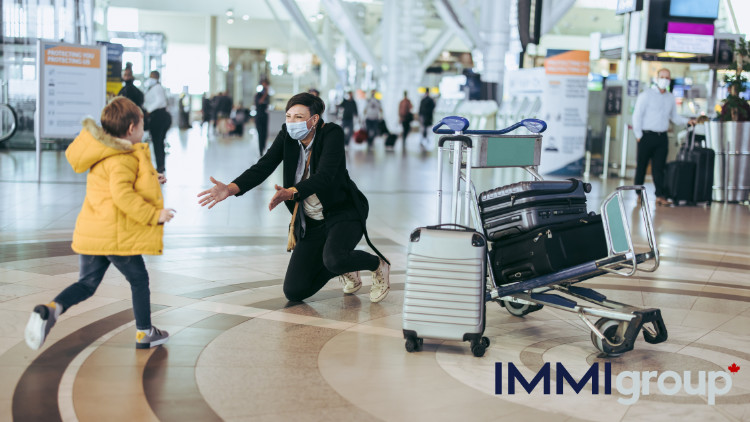
Table of Contents
Course: PR Travel Document (PRTD)
What happens if you’re outside of Canada and you don’t have your PR Card, or you are in Canada and must leave now; perhaps because it’s expired and your application to renew it is taking months? How do you get the documentation you need to travel back to Canada?
Just note, you can always leave Canada without a valid PR card, but you need a way back. This article will answer this question and a lot more.
P ermanent Resident Travel Document ( PRTD ) in order to return to Canada. Here are 7 Simple Steps to get that document and travel back to your home in Canada.
To be eligible for a PRTD, you must:
- Be a permanent resident of Canada
- NOT have a PR Card
- Be OUTSIDE Canada
You’ll notice that returning to Canada by car or truck is not included. We cover this in our FAQs at the end of this article.
Please remember that while your PRTD is valid for 6 months from the date it was issued, it is normally only valid for ONE SINGLE ENTRY into Canada. After that, it can’t be used again. So, you apply for and receive your PRTD and use it to enter Canada. As soon as you get back to Canada, you should apply to replace your lost/stolen/destroyed PR Card.
Let’s now dive into the steps you’ll take to apply for your PRTD.
Tip: If you have your Record of Landing and you leave Canada by plane BUT on the way back you land in the United States airport, let’s say an airport near the Canadian border and you drive back to Canada. You can enter without a PR card or Travel Document. Remember, this will only work if you can enter the United States (you have a U.S. visa in your passport or you are visa exempt)
Step 1: Get the Application PRTD Application Package
Go here to download the forms and checklist you’ll need to apply. They are as follows:
- IMM 5627 – Document Checklist Applying for Permanent Resident Travel Document
- IMM 5524 – Application for Permanent Resident Travel Document
- IMM 5476 – Use of a Representative (if applicable)
- IMM 5529 – Instruction Guide
Remember to right-click on the link and choose save link as … from the menu. Save the IMM form to your computer, and then open it with Adobe Acrobat from there. Otherwise, it will not open, read more about this issue here .
Before we start, let’s talk about the elephant in the room or in other words the biggest issues people have with this application:
- Can I get this document before leaving Canada? The answer is, unfortunately, no . You can expedite your application for your new PR card and wait; is the safest thing you can do. To see an up-to-date timeline on PR cards, click here.
- I am worried I have to send my passport in the mail, is there a better way? There are 291 Canadian diplomatic missions globally, you will need to check if they except walk in service. Just remember the information on some of the website is at times out of date, so just double-check everything. The other tip is if you are still in Canada and have not left, complete the package now and have everything ready before you leave on your trip. Just remember to read this article thoroughly; it will help you get everything in order as well as give you some helpful tips.
Step 2: Print and use your Document Checklist – IMM 5627
Let’s look at IMM 5627, your Document Checklist, which you should download and print right away to use as a guide during the application process.
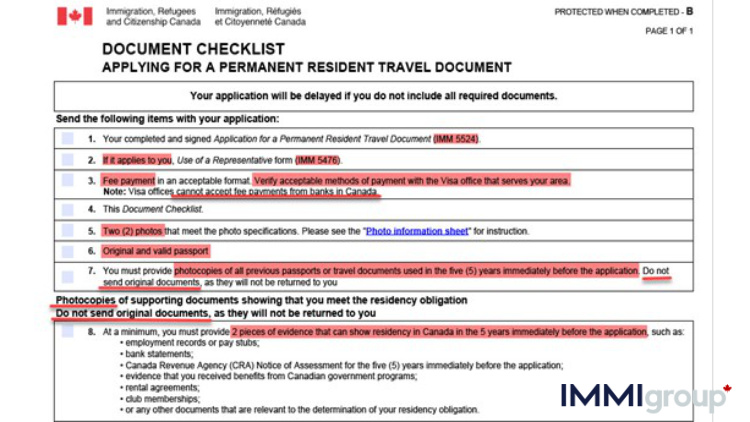
The first 8 items in your Document Checklist detail:
- The forms you need to fill out and sign and date, including form IMM 5627 – the checklist itself
- Proof of fee payment. You’ll have to check with your local VAC (Visa Application Centre) to see what payment forms they accept. PLEASE NOTE that VACs do NOT accept Canadian Debit Card payments.
- The link takes you here . Print out the page and take it to the photographer, who hopefully understands English. If they don’t, you’ll have to carefully translate the specifications to them, which are as follows:
- 50 mm x 70 mm
- Face measuring 31 mm to 36 mm from head to top of head
- Neutral facial expression (no smiling) with head and shoulders centred
- Plain white background
- Your name & date of birth
- Name & complete address of photography studio
- Your original and valid passport (since you’re a PR, you won’t yet have your Canadian passport, obviously).
- Photocopies of ALL the passports and/or travel documents you’ve used in the previous 5 years, with the relevant pages showing your travels as well as the information pages.
- At least 2 supporting documents you need to prove your residence in Canada. Send photocopies of these. DO NOT send originals. They won’t be sent back to you.
Tip: Contact family or friends back in Canada if you don’t have the supporting documents on you. They should take photocopies and scan the documents (things like driver licenses or bills proving your residence in Canada) and send the scanned images to you by email, so you can print them out.
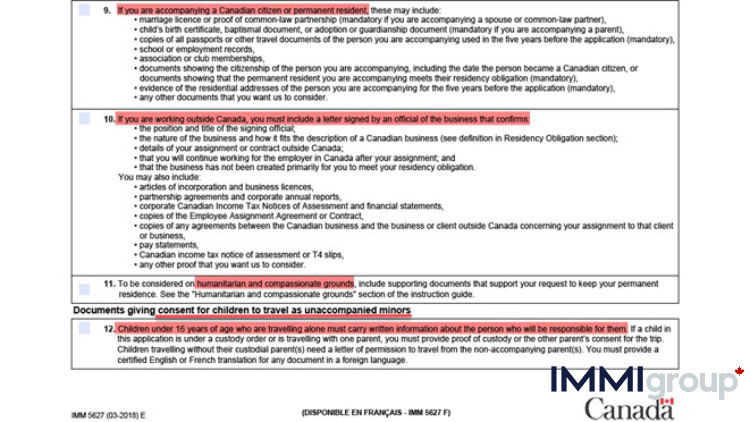
- Question 9 lists other supporting documents you can send if you are with a permanent resident or Canadian citizen
- Question 10 details the official letter you need to include if you’re working outside of Canada.
- Question 11 deals with evidence for applying on humanitarian & compassionate grounds , while
- Question 12 deals with what additional supporting documents an unaccompanied minor (under 16 years of age) needs to be able to travel without both or without one parent.
So, remember. Gather each completed form and supporting document and check the box when you have each one. Print the Document Checklist (IMM 5627) and remember to send it with your application package.
Tip: Did you know 90% of people are trying to get a Travel Document before they leave Canada. In most cases, it’s because their PR card has expired, and they don’t have enough time to renew it.
Step 3: Filling in IMM 5524 Application for Permanent Resident Travel Document
The first parts of form IMM 5524 are mostly straightforward personal information.
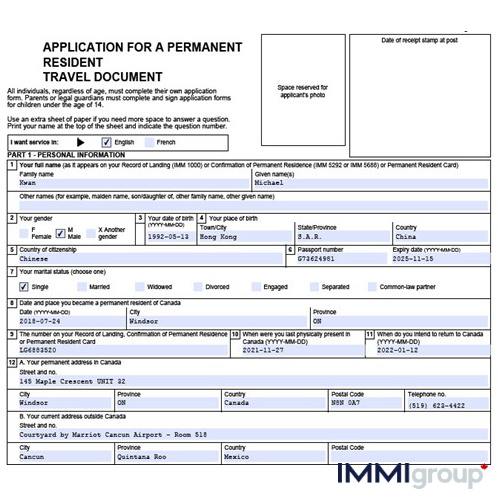
- Use the information in your Record of Landing (IMM 1000) or COPR (IMM 5292 or IMM 5688).
- Question 9 asks for your identifying number on your Record of Landing or COPR.
- Questions 10 and 11 ask when you were last in Canada and when you plan to return to Canada. In other words, 10 and 11 are about your immediate travels that resulted in you being stuck abroad with no PR Card
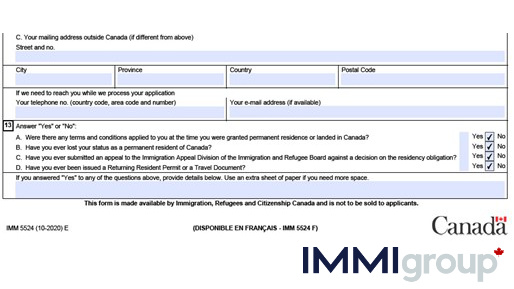
- The address you list in 12C (which is normally different from your permanent address listed in question 12 ) is your contact address for the duration of your application for a PR Card. So, if you’re stuck overseas, put whatever location (hotel, apartment, rented house etc.) where you are currently living abroad and where they will send your PRTD.
- Question 13 basically asks if you have had any conditions imposed on your PR status, or made any appeals, or had a loss of status of permanent resident at any point since becoming a permanent resident. If you need more space for details add a sheet of paper. In our example above, Michael Kwan has no conditions or previous loses with his PR card.
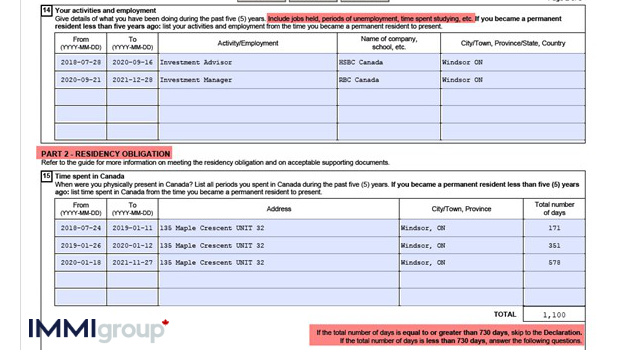
Because you’re replacing a PR Card through this application, IRCC want to be sure you’ve complied with both residency and any other requirements during your time as a permanent resident, so they ask you in question 14 to list all your activities for the last 5 years, or since becoming a PR if less than 5 years. That means work, study, unemployed, etc. DO NOT leave periods of time as blank space . That’s a great way to invite further requests for information from IRCC.
Warning for all permanent residents: If you have been outside of Canada for more than 730 days then you must read this : When you get to 675 days outside of Canada, you are extremely close of triggering an investigation into your PR status. IRCC will request you to file an application called Residency Questionnaire (RQ), read more about this here.
Most people make the mistake of thinking they are okay because they are not over the 730 days, they may be close but not over, so they file an application causing an investigation into their PR status . This will result in a mountain of paperwork (read article link above to see what the paperwork looks like), thousands of dollars in legal fees, stress and a lot of time. After getting to the point where you’ve spent close to 730 days outside of Canada, you will then be put under a microscope every time you travel or when you file for a new PR card or apply for Canadian citizenship .
Exception to this rule is: if you are living overseas with a spouse or common-law partner that is Canadian. This is your ticket to not triggering a Residency Questionnaire , just make sure you have loads of documents proving you have always been living together.
Here is what you can do:
- Don’t file for a Travel Document if you are in Canada. What you should do is stay put until you are below 650 days.
- If you are outside of Canada, we strongly recommend you hire someone, it does not have to be Immigroup, but do hire someone that has a lot of experience it ‘status in jeopardy’ cases.
- When filing your PR card renewal application, be extremely thorough in proving you meet the requirements in Canada. Send as many supporting documents as possible; it’s better to send too much than send too little.
- Hire an expert like Immigroup, we only file applications that meet the requirements of IRCC. It’s worth the money to have a professional representing you – keep in mind that we have over a decade of experience in ‘status in jeopardy’ cases.
- If you do trigger a Residency Questionnaire (RQ), hire someone to at least review it before filing. Just make sure they have a lot of experience in these types of cases.
Although it comes after the residency requirements , let’s deal with question 18 here. Question 18 is where you consent to allowing the IRCC to access your tax data at the Canadian Revenue Agency (CRA). It is strongly suggested you click on Yes . If you click No, you may be subject to further requests for information which will slow down your application.
Residency Requirements and Form IMM 5524
Next comes the most important part of your application – the Residency Requirements. As you may remember, when applying for and receiving your PR visa in your passport you were told about what the residency requirements were for a permanent resident. Let’s summarize them again:
You need to have been physically present in Canada for at least 730 days during the last 5 years. The days physically present in Canada:
- DO NOT have to be continuous
- You’re working abroad full-time for a Canadian business/organization or for the federal or a provincial/territorial government.
- A Canadian citizen, OR
- A Permanent resident working full-time abroad as described immediately above
Questions 15, 16, and 17 all deal with residency requirements for Permanent Residents.
- Question 15 is shown in the previous image. If you get a total of 730 or more days just by filling in the details of your travels in question 15, skip straight to the declaration (signing and dating the form basically) and leave questions 16 and 17 blank. Even if you did work abroad or accompany a parent abroad, there’s no need to answer them as you’ve already complied with the residency requirements. You’re good as long as you’ve also answered question 18 as we mentioned above. Sign and date the form and move on to the next step.
In our example, Michael Kwan has been in Canada for over 1,000 days so he can skip questions 16 and 17 .
However, if you get a total of less than 730 days in question 15, you’ll have to answer questions 16 and 17.
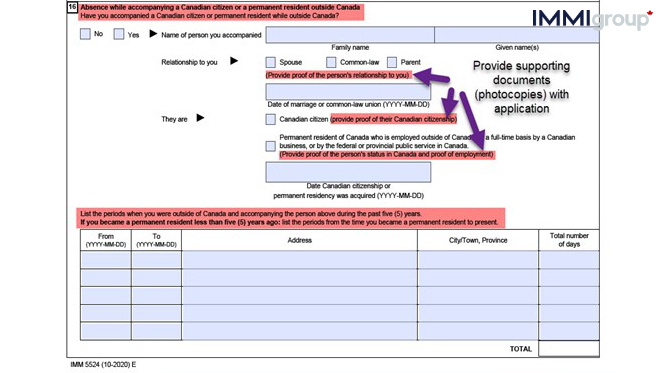
Question 16 deals with travels abroad as a dependent child (under the age of 19 normally) and please remember you will need to provide proof of your parent’s Canadian citizenship or proof of their PR status and their employment abroad.
Question 17 refers to permanent residents who worked abroad for Canadian businesses, organizations, or the federal or a provincial/territorial government.
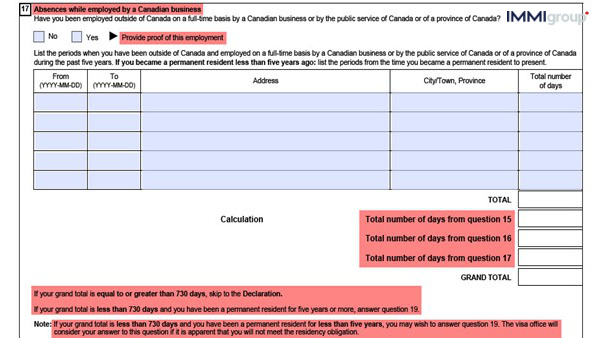
After completing questions 16 & 17, add up the number of days in questions 15, 16, and 17 (remember what we’re doing is adding days lived abroad that qualify as residence in Canada to your days physically present in Canada). If your total is more than or equal to 730 days, sign and date the declaration and move on to the next step.
However, if your overall total number of days is less than 730, you have to answer question 19 where you provide reasons why you were not able to meet the residency requirements under Humanitarian & Compassionate grounds (H&C) . You must convince IRCC officials with compelling reasons such as: the best interests of a child and/or hardship.
Tip & Warning: if you have a Humanitarian & Compassionate case you will have to create your own Letter of Explanation, you can find a do-it-yourself article here . Strong warning , you need to have experience in creating these types of letters, ether from your university years or profession. It is not an emotional appeal; this is the biggest mistake most people make. If in doubt, hire someone! Immigroup offers support around these matters, contact us today.
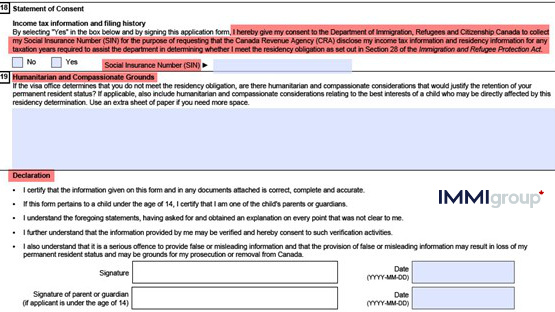
We mentioned question 18 – consenting to giving IRCC access to your tax information – before dealing with Residency Requirements, so remember that the recommended option is to click Yes and give your SIN.
For question 19 , what you have to do is describe the hardships you and your family would face if you lost your status as a permanent resident. This can include the negative consequences it would have on any children affected by the loss of your PR status. Gather any supporting documentation that show there were exceptional circumstances that prevented you from meeting your residency requirements.
Step 4: Using a Representative
We deal with representatives (form IMM 5476) here , so follow the link to see how to appoint (or cancel) a representative.
Tip : You can add a member of the family or friend to this document. The benefit here is they can check the status and speak to the government on your behalf. This is great when you are busy. Just remember that the person you pick is an unpaid representative so they can’t get any financial compensation for this service, otherwise you are breaking the rules.
Did you know when hiring Immigroup, we ask you to sign this form IMM 5476 because it gives your legal representative the ability to 1), check the status of your application, 2), contact IRCC (the government) on your behalf and 3), respond to IRCC on any request they may have.
Step 5: Paying your fees
Go here and select the country you’re applying from as well as the type of application, as shown below:
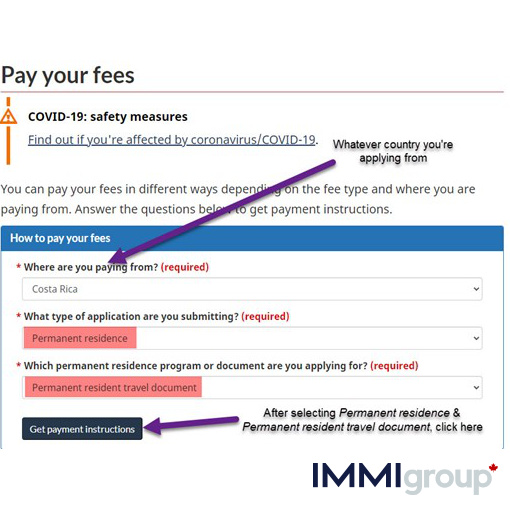
You will then be taken here in our example of someone applying for a PRTD from Costa Rica:
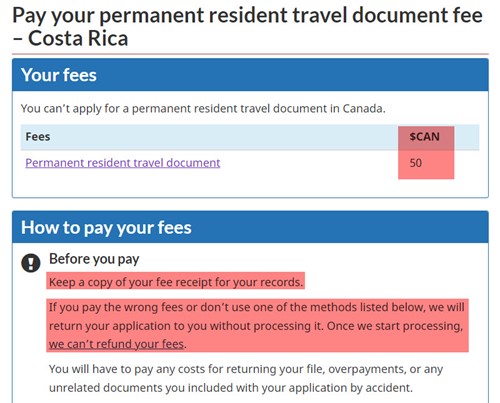
The fee for a Travel Document (PRTD) is CDN$50.00
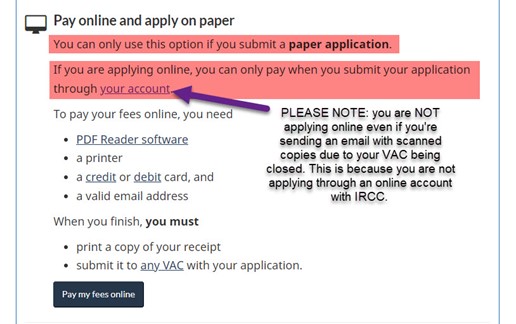
Click Pay my fees online to pay using a valid Credit Card or Debit Card. Remember, you can only use this option to pay your fees if you’re applying on paper. As we show below, you may have to send your application by email using scanned (electronic) copies of your forms and supporting documents if your local VAC is closed. However, this is NOT an online application; it is an application by email, so pay your fees as shown here. And as always, you may be able to pay your fees at the VAC. Always check with your local VAC to see what forms of payment they accept.
Step 6: Where to Apply & What to do if your VAC is closed due to COVID
Given the persistence of the COVID-19 pandemic, you may find that your local Visa Application Centre is closed. Always contact your local VAC as soon as you realize you have to apply for a PRTD. If they are closed, you will have to submit your application by email.
- Permanent Resident Travel Document applications are normally submitted on paper.
- However, if COVID restrictions have closed your nearest VAC, then you are allowed to submit your application by email.
To apply by email, do the following:
- Print your document checklist form IMM 5627
- Using IMM 5627, fill in and sign and date form IMM 5524 and any other forms like IMM 5476 and gather any supporting documents you are required to submit.
- Scan the forms/documents (make electronic copies) and upload them to your pc.
- Pay your fees as shown in Step 5 and make sure you get a copy of your payment receipt.
- [email protected]
- PLEASE NOTE: Your Subject Line in the email should read as follows:
- “PRTD application” : your name here “first” and “last name” (it’s a good idea to capitalize your last name).
- For example, if your name is Sean Chen, write: PRTD application: Sean CHEN
- Subject line as shown directly above
- Scanned copy of IMM 5524 – Application for a Permanent Resident Travel Document
- Scanned copies of all supporting documents as indicated by your document checklist, including a scanned copy of your document checklist itself Tip: scan your documents in colour and convert it to PDF. Don’t use JEPG unless you know how to make the image small without losing resolution. If you don’t know how to do this part you can YouTube it, just type in the words “how to scan and save to PDF”
Warning: Don’t send shared links to the government (example: Google Drive or DropBox), in most case they will not open it because of security reasons. Don’t password protect your documents, IRCC does not take kindly to this.
- Scanned copy of your travel itinerary if possible
- Scanned copy of your payment receipt
- Once you have sent the email and IRCC has processed your application, you will receive instructions on where to send your passport. PLEASE NOTE: applications by email for PRTDs TAKE LONGER than applications on paper.
- PLEASE NOTE: DO NOT book your return trip to Canada until you’ve received your passport back with a PRTD sticker in it.
Step 7: Submitting your Application Tavel Documents Applicaiton
In a sealed envelope, submit:
- Your original travel passport (the passport you used to travel outside of Canada)
- All supporting documents (copies of the required documents)
- Your completed, signed and dated form IMM 5524
- Your Document Checklist form IMM 5627
- A copy of your fee receipt
To see where to submit your application, go here and scroll down until you see the following:

We’ve chosen Costa Rica as our example of the country we’re applying from. Click the blue Continue button to go here:
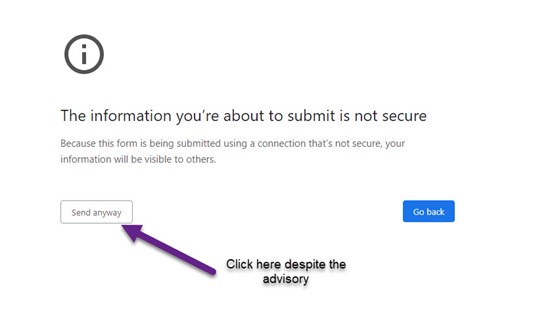
You may see the above advisory page. If you do, click on the Send anyway button. This will take you here to the instructions page for Costa Rica:
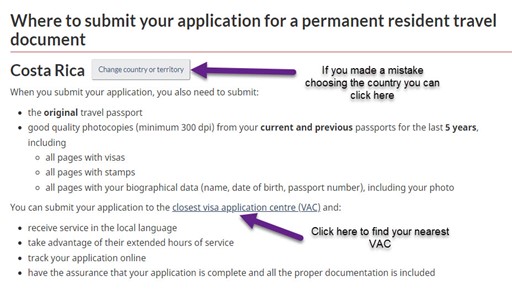
Click on the underlined link to find your VAC closest to you. It will take you to the following page where you will need to write the name of the nearest major city in the search box to find your nearest VAC.
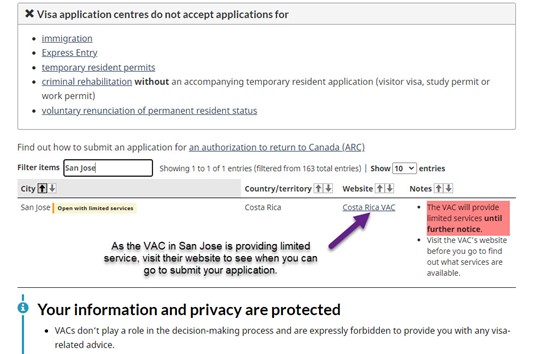
As the VAC in San Jose, Costa Rica (it’s best to choose by city rather than country) is offering limited services as of late 2021, make sure you visit the website to see exactly when you can go to submit your application for a PRTD.
That’s it! You’ve put together and submitted your application for a PRTD. Now you just have to wait for your passport with a PRTD sticker in it to then book your flight back to Canada.
Can I get an ETA instead of a Travel Document?
No you can’t. Once you become a permanent resident of Canada, you are no longer merely a visitor to Canada – even if you travel outside Canada for a short holiday. As a permanent resident to Canada, to enter Canada you must have either: your PR card OR you Permanent Resident Travel Document. For returning to Canada from the U.S. by car, see below.
I hold a strong passport, why can’t just enter without my PR card or Travel Document?
For example, if you had a strong passport like a British one, if you’re visiting Canada and you’re not a permanent resident, you would just need an ETA to enter Canada. Unfortunately, because you are now a PR card holder, you are no longer eligible for an ETA as we explained above.
What if I can get back to Canada without my PR card or Travel document; what will happen?
If you can make it back, not much will happen in most cases. The reality is once you are back in Canada, the most that will happen is you will get a long talk from a CBSA official. In some rare cases, for example, if you have lost your permanent resident status in Canada or your close to losing it , you could be put on a plane and sent back.
I am thinking of driving to a U.S. airport and coming back to Canada by car; will this work?
Technically it should work. The only thing to watch out for is make sure your home country passport does not require a U.S. tourist visa to enter the United States. So, for example if you have a passport that is visa-exempt in the U.S. you might consider this option.
I lost both my passport and PR card; can I just apply for an emergency Passport form the Canadian embassy.
In most cases no, Passport Travel Documents or Certificates of Identity are issued to Canadian Passport holders or Refugees and Protected Persons. In rare exceptions, they can be produced if your home country’s diplomatic mission is in such disarray that they can’t assist you. Remember, you would have to make your case to the Canadian diplomatic mission nearest you. Tip: Keep it logical not over the top emotional (you will stand out from the other appeals)
What if I don’t get my Passport back in time for departure date?
You would have to change your flight and get the new date on your ticket. Tip: Before buying your ticket ensure that you have rebooking or cancellation policy.
I am trying to get an answer on the status of my Travel Document, what do you recommend?
Here are some tips to follow: How to request an update from a diplomatic mission . Also, don’t forget to try calling, emailing, and going in person. The more you do, the better your odds of getting an answer.
I filed a Travel Document application and couriered it to the Canadian embassy, but it seems they lost my package. What do I do know?
Unfortunately, you would have to reapply for a lost Passport from your home country’s embassy. In most cases this could take some time, so make sure you request an emergency passport. Most countries have this; the passport is only good for one year but can be used to travel back to Canada.
I am applying for a Travel Document, but I have a change of name now, so what do I do?F
Just make sure you have the legal document showing the new name. For example, a marriage certificate , or legal change-of-name document will work. As well, it’s a good idea to bring the originals with you on your trip if you know you’re going to be applying for a PRTD.
I have been outside of Canada for many years, I am sure I am not a Canadian permanent resident anymore, but now I am trying to return to Canada. Should I apply for a Travel Document?
As we explain in the tutorial, in Step 3, the residency requirements are at least 730 days physically present in Canada during the previous 5 years, along with time spent abroad under certain conditions. However, the key point is that you only lose your PR status when an official with the Canadian government determines you are no longer a permanent resident. What you can do in this situation, is apply for a Permanent Resident Travel Document and see what happens. Remember, you can appeal a negative decision on your PRTD application as well.
Tip: Hire a professional asap if you are out of status. This is key because most people assume they will only hire and spend the money If their appeal fails. Unfortunately, it’s a big mistake to wait until after your appeal fails before you hire someone. The reason this is a big mistake is because while the damage was bad before, now that your appeal has failed it’s close to impossible to fix. As well, legal costs at this point will mount to three to five times more than if you had hired a professional as soon as you were out of status. Here at Immigroup, we have been dealing with issues like this for over a decade. Just book in an hours’ worth of consultation and you will see the difference experience makes.
Do I lose my PR status when my PR Card expires?
No you don’t. As we explain directly above, you have to go through an official process to lose your permanent resident status. It usually involves one of the following situations:
- An adjudicator determines you are no longer a permanent resident after an inquiry or a PRTD appeal,
- You voluntarily renounce your PR status,
- You have a removal order against you which is enforced, OR
- You become a Canadian citizen.
Is a PR Card still a travel document when it has expired?
No, it is not. A PR Card has to be valid (not expired) to be accepted as a travel document. If it expires, you need to apply for a PRTD from abroad or apply for a new PR Card while still in Canada. Always check the expiry date on your PR Card before you travel because some PR Cards are only valid for 1 year, although most are valid for 5 years. If your PR Card will expire in 6 months or less, apply for a new one if your immediate travel plans allow that. Unfortunately, waiting times for a renewed PR Card can involve several months and even up to 6 months.
What did we miss in this article? Please let us know and others that come after you will get a better experience. Also, we are happy to answer any question not listed in this article. Send us a message below. Tip: Did you know Immigroup has a community forum that can help you answer your Travel document questions ? Click the link and start today!
Have someone from our team call you back and answer all your questions.
People who read this, how to secure an expedited or regular us visa appointment in canada, how to get a refugee travel document in canada., how to become a truck driver in canada, free spousal sponsorship course, got questions, community forum, sign up & stay informed.
Official websites use .gov A .gov website belongs to an official government organization in the United States.
Secure .gov websites use HTTPS A lock ( A locked padlock ) or https:// means you've safely connected to the .gov website. Share sensitive information only on official, secure websites.
- Create Account
International Travel as a Permanent Resident
In general, you will need to present a passport from your country of citizenship or your refugee travel document to travel to a foreign country. In addition, the foreign country may have additional entry/exit requirements (such as a visa). For information on foreign entry and exit requirements, see the Department of State’s website .
If seeking to enter the United States after temporary travel abroad, you will need to present a valid, unexpired “Green Card” (Form I-551, Permanent Resident Card). When arriving at a port of entry, a U.S. Customs and Border Protection Officer will review your permanent resident card and any other identity documents you present, such as a passport, foreign national I.D. card or U.S. Driver’s License, and determine if you can enter the United States. For information pertaining to entry into the United States, see U.S. Customs and Border Protection’s webpage .
Permanent residents are free to travel outside the United States, and temporary or brief travel usually does not affect your permanent resident status. If it is determined, however, that you did not intend to make the United States your permanent home, you will be found to have abandoned your permanent resident status. A general guide used is whether you have been absent from the United States for more than a year. Abandonment may be found to occur in trips of less than a year where it is believed you did not intend to make the United States your permanent residence. While brief trips abroad generally are not problematic, the officer may consider criteria such as whether your intention was to visit abroad only temporarily, whether you maintained U.S. family and community ties, maintained U.S employment, filed U.S. income taxes as a resident, or otherwise established your intention to return to the United States as your permanent home. Other factors that may be considered include whether you maintained a U.S. mailing address, kept U.S. bank accounts and a valid U.S. driver’s license, own property or run a business in the United States, or any other evidence that supports the temporary nature of your absence.
If you plan on being absent from the United States for longer than a year, it is advisable to first apply for a reentry permit on Form I-131 . Obtaining a reentry permit prior to leaving the United States allows a permanent or conditional permanent resident to apply for admission into the United States during the permit’s validity without the need to obtain a returning resident visa from a U.S. Embassy or Consulate abroad. Please note that it does not guarantee entry into the United States upon your return as you must first be determined to be admissible; however, it will assist you in establishing your intention to permanently reside in the United States. For more information, see the Travel Documents page.
If you remain outside of the United States for more than 2 years, any reentry permit granted before your departure from the United States will have expired. In this case, it is advisable to consider applying for a returning resident visa (SB-1) at the nearest U.S. Embassy or Consulate. An SB-1 applicant will be required to establish eligibility for an immigrant visa and will need a medical exam. There is an exception to this process for the spouse or child of either a member of the U.S. Armed Forces or civilian employee of the U.S. Government stationed abroad on official orders. For more information on obtaining a returning resident visa, see the Department of State’s webpage on returning resident visas .
Additionally, absences from the United States of six months or more may disrupt the continuous residency required for naturalization. If your absence is one year or longer and you wish to preserve your continuous residency in the United States for naturalization purposes, you may file an Application to Preserve Residence for Naturalization Purposes on Form N-470. For more information, please see the Continuous Residence and Physical Presence Requirements page.
If you lose your Green Card or reentry permit or it is stolen or destroyed while you are abroad, you may need to file a Form I-131A, Application for Travel Document (Carrier Documentation) . This carrier documentation will allow an airline or other transportation carrier to board a lawful permanent resident bound for the United States without the carrier being penalized. For more information, please see the Form I-131A, Application for Travel Document (Carrier Documentation) page.
More Information
- Welcome to the United States: A Guide for New Immigrants (PDF, 3.57 MB)
- How Do I Get a Reentry Permit? (PDF, 667.32 KB)
- I-131, Application for Travel Document
- I-90, Application to Replace Permanent Resident Card
Other USCIS Links
- Green Card Resources
- How Do I Help My Relative Become a Lawful Permanent Resident? (PDF, 577.38 KB)
- How Do I Renew or Replace My Permanent Resident Card? (PDF, 550.19 KB)
- "How Do I" Guides for Permanent Residents

Crea tu nueva lista

Guide to Completing the Puerto Rico Travel Declaration Form

Updated: March 10, 2022
Following Governor Pedro Pierluisi’s executive order on March 7, all travelers — domestic and international — will no longer need to complete the travel declaration form. For updated information on the elimination of pandemic-era protocols in Puerto Rico, click here .
Puerto Rico was recently announced as the most vaccinated place in the U.S., so suffice it to say that it takes safety seriously amid the ongoing coronavirus pandemic. In efforts to keep both travelers and locals safe, all passengers entering Puerto Rico are required to complete the Travel Declaration Form and present a negative test, regardless of vaccination status.
From February 2nd, vaccinated travelers arriving in Puerto Rico on domestic flights will no longer have to present a negative COVID-19 test on arrival. Unvaccinated visitors are still required to present a negative test, taken within 48 hours of landing, but they will only need to quarantine until they receive a negative test result. International travelers will need to take a COVID test within one day of departure. Note that unvaccinated travelers arriving from a domestic or international destination without a molecular or antigen test may incur a $300 fine, which can be waived if the person provides a negative test or proof of a test performed within 48 hours of arrival in Puerto Rico.
Steps to complete Puerto Rico’s online travel entry form
The form is available through the Puerto Rico Health Department’s online “TRAVELSAFE” portal , which details other important health-related information regarding travel to the U.S. territory. Click on the link to the form, log in or create a “TRAVELSAFE” account if you are filling out the form for the first time.
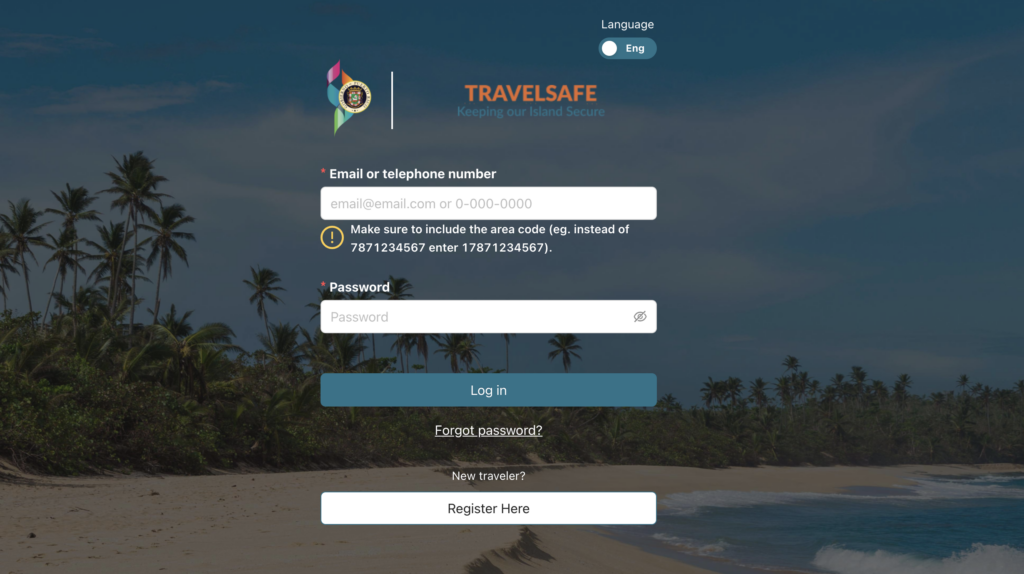
After registering, a written notice details Puerto Rico’s travel requirements and assures that the requested information will be kept confidential. In addition to all adults traveling to the U.S. territory completing the declaration form, dependent minors’ information must be entered in the same form as the adult(s) they are traveling with.
For minors traveling without an adult, their supervising adult must complete the travel declaration form before they fly or board a ferry to Puerto Rico.
The Puerto Rico health department emphasized just how important travelers’ collaboration is to keep the island safe.
Everything you need to register online
Once you click “Continue,” you will be required to enter your name, gender, date of birth, contact information and language preference (Spanish or English). Come prepared with your passport or driver’s license to complete the next few steps of the process, which will also ask where you reside.
Additionally, the registration will inquire whether you are vaccinated against COVID-19. If you received the inoculation, for this step you will need to provide proof of vaccination status when your profile is created.
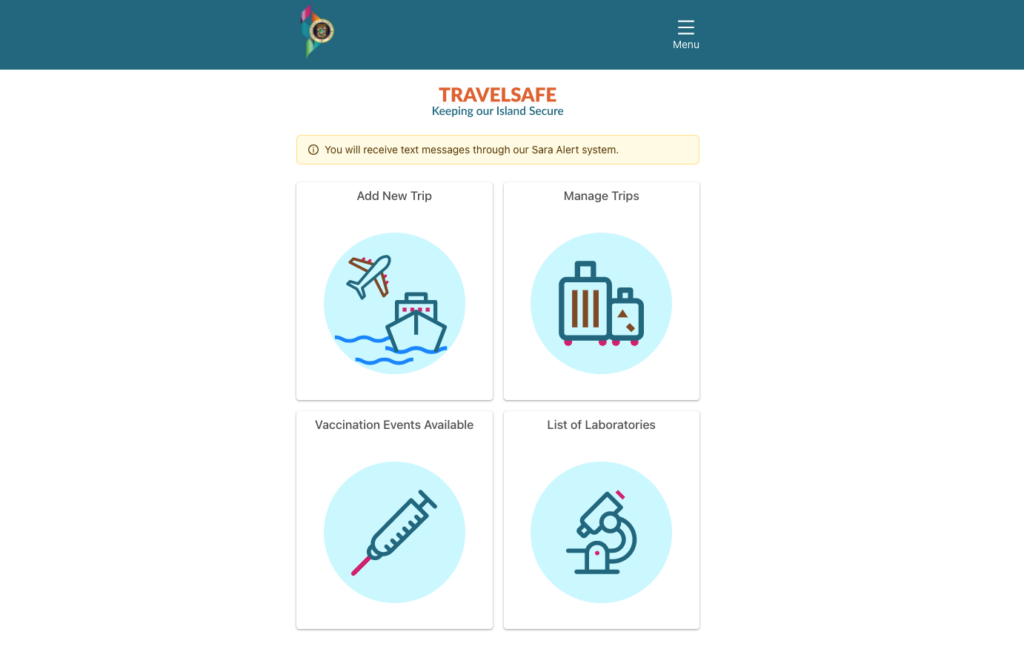
When registration is complete, you enter your “TRAVELSAFE” account, which will give you options to “Add New Trip” or “Manage Trips.”
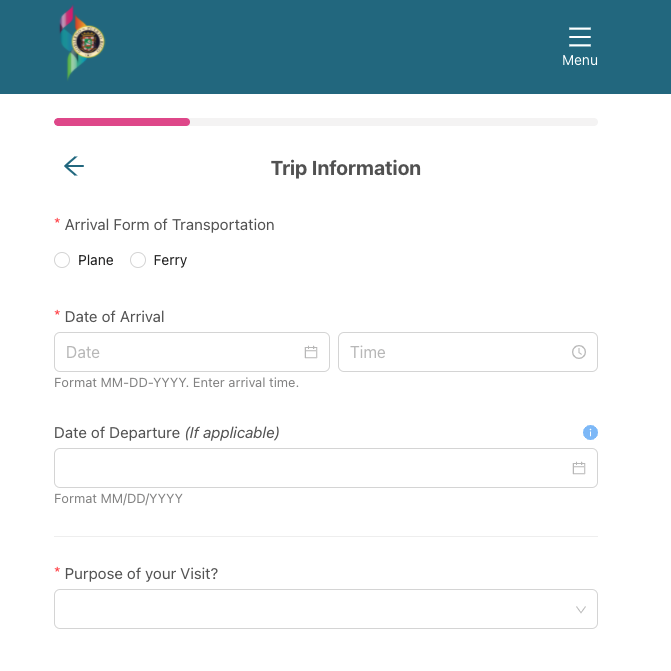
The form for new trips will ask for the form of transportation (plane or ferry), arrival date, departure date (if applicable), purpose of visit, length of trip, place of stay, among other information.
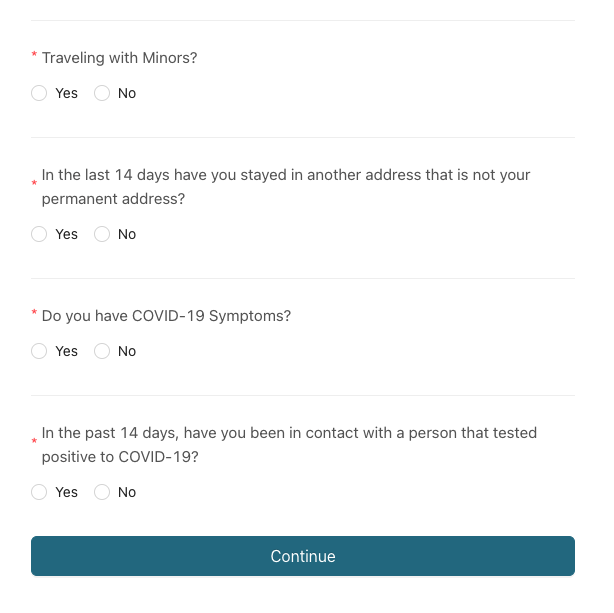
Questions like “Do you have COVID-19 symptoms?” and “In the past 14 days, have you been in contact with a person that tested positive to COVID-19?” are also on the form. The form will prompt you to identify any symptoms such as fever, chills, cough or diarrhea. It will also ask for the exposure date if you came in contact with someone COVID-positive. Once you have completed the questionnaire, you can manage your trips in your “TRAVELSAFE” account.
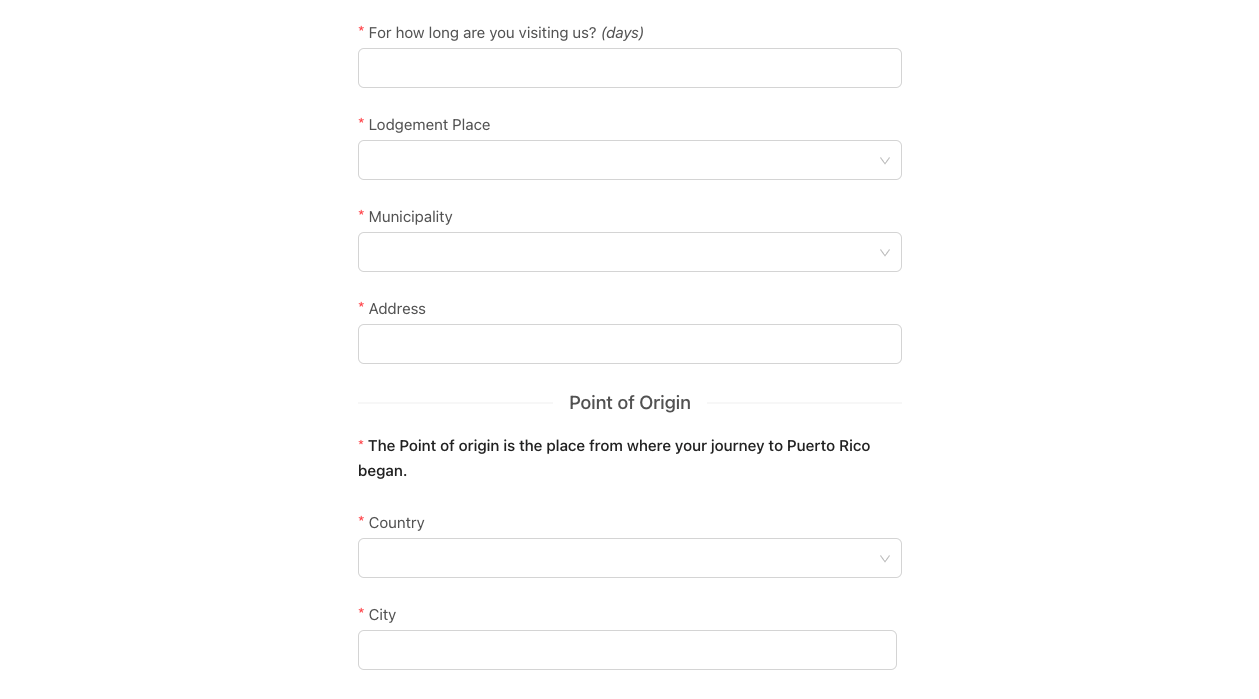
For vaccinated travelers
If you are fully vaccinated, then in the upper right corner in your “TRAVELSAFE” home page, you will see a drop-down menu that shows “Vaccine.” Here is where you will update your vaccine information, including type, 1st and 2nd COVID-19 dose, as well as an option to upload a copy of your vaccination card. JPEG or PDF file formats are accepted.
According to the Puerto Rico health department, people are fully vaccinated when it has been at least two weeks after the second dose of the Pfizer or Moderna vaccines or sole dose of Johnson & Johnson’s Janssen vaccine.
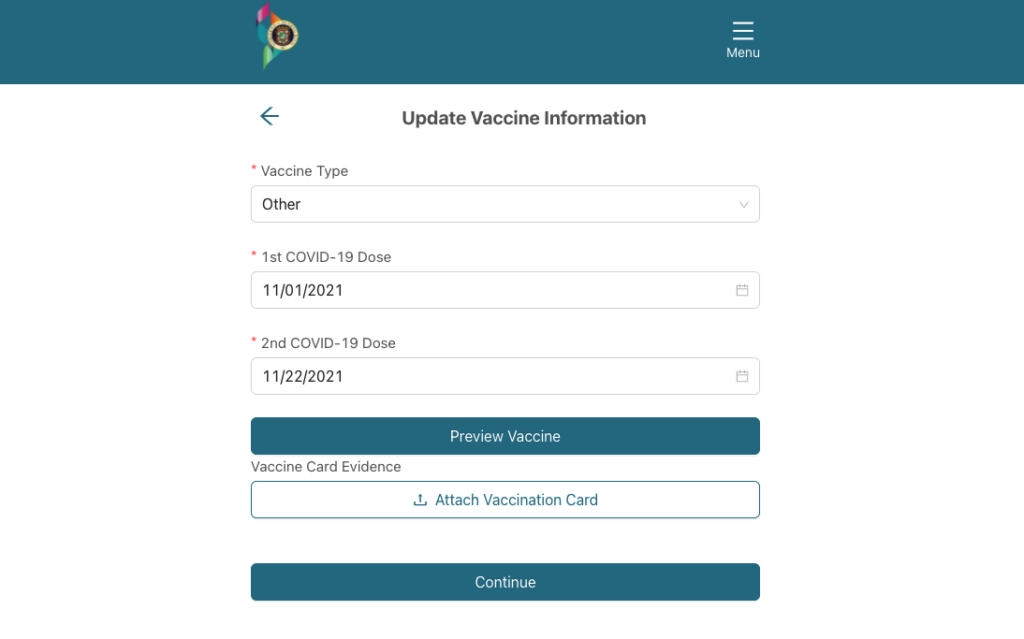
For unvaccinated travelers
As with all passengers, any person over two years old who is not fully vaccinated must provide evidence of a negative COVID-19 test within 48 hours prior to their arrival on the island. Passengers arriving in Puerto Rico without a COVID-19 test result will be issued a $300 fine. But if the traveler provides proof of a test within 48 hours of arrival, then the fine will be waived. Unvaccinated travelers will need to quarantine pending a negative COVID-19 test.
For a list of facilities that offer COVID-19 testing, visit the U.S. Department of Health and Human Services website on community-based sites.
Most restaurants and activities on the island are now asking for proof of vaccination cards.
Other travel-related FAQs
If you need more information or have additional questions regarding Puerto Rico’s travel and entry requirements, the government’s travel help center can be reached by phone (939-592-5115) or email ( [email protected] ).
See our full guide on Puerto Rico’s travel protocols, safety restrictions and COVID-19 updates for further details ahead of your trip.
Final checklist
Whether you are travelling internationally or domestically, we have you covered. These infographic outline what you need to know and do ahead of arriving to Puerto Rico.
Domestic Travelers
Click for full view.

International Travelers

Click on either image to download a PDF version and find out more on how you can travel safely.

MAKING YOUR IMMIGRATION GOALS A REALITY THROUGH PERSONALIZED, PROFESSIONAL, INTEGRATED SERVICE.
1 (905) 800-1630
Start your journey today, 1- 833-800-1630, [email protected].

IMMIGRATION STATION CANADA
Professional Immigration Advocates
- Nov 15, 2020
Permanent Resident Travel Documents (PRTD)
Updated: Jan 5, 2021

What is a Permanent Resident Travel Document (PRTD) and how can it help me?
You need a valid permanent resident (PR) card to return to Canada by plane, train, bus or boat. If you know your card is going to expire when you’re travelling, you should renew it before you leave Canada because you can only renew your card in Canada. The Canadian government will not send PR cards to non-Canadian addresses and they also won't allow you to have your card sent to a third party such as our office.
If you’re outside Canada and don’t have a valid PR card, you will need to apply for a permanent resident travel document (PRTD) to return to Canada. You can only apply for a PRTD from outside Canada. If you try to return to Canada without a PR card or PRTD, you may not be able to take your flight, train, bus or boat to Canada .
Don't worry, if your card expires when you’re outside Canada, you still have your permanent resident (PR) status as long as you have met your residency obligation. For PR this is 2 years in every 5 years that you are a permanent resident of Canada, or 730 days in every 1825 days. For more information on residency obligation click here.
What happens if your PR card expires when you’re outside Canada? This will depend on how you plan to return to Canada.
Private vehicle.
There are other documents you can use to re-enter the country.
When you return to Canada, apply for a PR card if you plan to travel outside Canada again.
Some examples of private vehicles include, but are not limited to: a car, truck, motorcycle, or recreational vehicle that you own, borrow, or rent. It is a vehicle not available for public use.
Commercial vehicle: airplane, bus, train, or boat
You must apply for a permanent resident travel document (PRTD). Otherwise you may not be able to travel to Canada.
You can apply to replace your permanent resident (PR) card when you return to Canada or if you haven’t left yet. You may eligible for urgent processing .
Most PR cards are valid for five years, but some are only valid for one year. The expiry date is printed on the card. When your PR card expires, you can’t use it as a travel document. If your PR card will expire within six months, you should apply to renew your card . You need to be in Canada. If you’re re-entering Canada by commercial vehicle and have an expired PR card, get your PRTD to re-enter Canada.
Check our processing times to see how long you will have to wait to get your new card.
If you need a PR Travel Document or would like to discuss your particular situation, please contact us for an appointment .
Immigration Station Canada is a dedicated, professional Canadian Immigration firm practicing out of Northumberland County , just east of Toronto , in Canada . We serve clients from Kingston, Belleville, Brighton, Cobourg, Oshawa, the GTA, Guelph, Milton, Stratford and St. Catharines and around the world . Our Regulated Canadian Immigration Consultant, Anne C. McCaughey (Annie) is an experienced immigration services provider and a fifth generation Canadian who values the immigration process and the unique individuals who immigrate to Canada to become part of the fabric of this wonderful country. If you would like to submit a question to Ask Annie, use the link located at the top right of the page.
How Can We Help?
We do work permits , study permits, visitor visas, Express Entry , spousal sponsorship, family class sponsorship, and Canadian citizenship with an expertise in Labour Market Impact Assessment (LMIA) applications and Global Talent Stream applications.
Please contact us if you would like assistance with your immigration application or to book an appointment.

Recent Posts
Accelerating Application Processing in Canada: Strategies for Faster Results
Understanding Spousal Sponsorship Refusals: Common Reasons and Solutions
Navigating LMIA Exempt Job Offers: Your Path to Working in Canada

Permanent Resident Travel Document (PRTD) Canada 2023
by Max Chaudhary | Nov 22, 2023 | Blogs , permanent resident | 55 comments
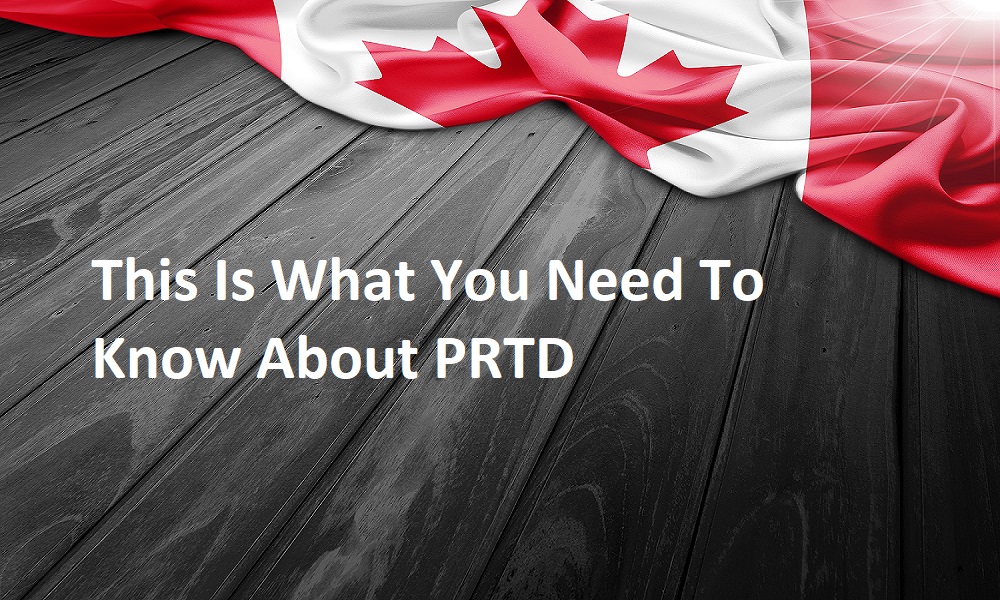
What is a Permanent Resident Travel Document (PRTD) in Canada?
The Permanent Resident Travel Document (PRTD) is a travel document issued by the government of Canada to permanent residents who are outside of Canada and do not have a valid permanent resident (PR) card to return to the country. Permanent residents of Canada are required to have a valid PR card or PRTD to board a commercial transportation (like an airplane) to return to Canada.
To show proof, you either need your PR card or PRTD Canada Visa document. A Permanent Resident Travel Document is akin to your ticket back to Canada as you travel back to the country through any commercial carrier such as bus, train, plane or boat). Without your PR card or your PRTD Canada, you will be denied entry.
PRTD Canada is issued to outside of Canada permanent residents when one’s PR card’s validity has expired or when one has lost it. The reasons can be many, but your PRTD Canada is the sole document that can help you get entry back into the country when you do not have a valid PR card.
What is the PRTD Canada Visa processing time?
The processing time for a Permanent Resident Travel Document (PRTD) in Canada is typically 2 to 8 weeks . It is recommended to submit your application at least 1 to 3 months before your planned travel dates. If you find yourself dealing with an emergency, the IRCC does make exceptions for PRTD applications in Canada and approves them when needed subject to their internal resources. Always remember that there is no guarantee, and you must apply for PRTD Canada in advance.
Can I enter Canada without PRTD?
As we discussed above, a valid PR card or a valid PRTD Canad a is required for anyone to get back to Canada using commercial modes of transport. If you are a permanent resident of Canada and do not have your PR card for any unforeseen circumstances, you must present your PRTD document. Without the PRTD document, you may not be able to board your flight, train or bus. It is your responsibility to make sure that you apply for PRTD Canada in time and get it approved.
How long is PRTD valid Visa for?
The typical PRTD validity time is usually six months from the date of issue. Once you have successfully applied for your PRTD Canada and received your approval, you can use your PRTD Canada document to travel typically six months from the date of approval. As soon as you enter the country, your PRTD become invalid, and that is crucial to remember. So keep in mind that you cannot use the same PRTD twice, even if it has not been six months since it was issued. This is not common, but sometimes immigration officers may choose to limit the time of your PRTD to less than 6 months.
How to apply for PRTD Canada Visa?
If you are looking to apply for PRTD Canada, all you need to do is fill out an application form. What comes next is more important. You want your application to go forward smoothly, without any obstacles. To do so, arrange your documents and present them in the order as suggested by the application form. This will make it easier for the officer examining your application to go through it. If hiring a representative for your case, you will need to use a representative form. The processing fee for PRTD Canada is $50, and you will mostly need to apply via the Visa Application Centres. But this will also cost premium fees.
What happens if PRTD is refused?
A refused PRTD means that you have lost permanent resident status and are a foreign national. However, according to Paragraph 63(4) of IRPA, a candidate whose application is refused can seek an appeal of the decision of a visa officer in Canada who has denied PRTD. A candidate has 60 days to appeal the decision from the date of the result of their previous application (or 30 days if your residency obligation was assessed negatively at a port of entry). You may need to attend a hearing held by the IAD for this if you have been in the country for 365 days. Our lawyers at Chaudhary Law have represented many candidates in the past and would be delighted to do so for you.
Canada PRTD processing time from India:
You can only apply for PRTD Canada from outside of the country. So if you are in India , you must apply for your PRTD document two to six weeks in advance, which means you have ample of time to travel and enter the country. You may not be able to board a flight from Canada to India if you don’t process this document. Our PR lawyers in Toronto are experienced and knowledgeable to handle any legal complications and guide you through visa application process. Given all the requirements are met, we guarantee a smooth transition for all your PR needs. To book a consultation, call 416-447-6118 .
55 Comments
Thank you for the latest update on PRTD. My family did our first landing in Toronto 5 months back and had to return to wrap up our life in UAE. I, the wife am the primary applicant and received my PR card in three months. But my husband and children have not received it to date. I am travelling next month to start my job in Toronto and want my family to join me in time for kids to join school in September. Is it best to reapply for PR card or go for PRTD ? Appreciate your advice as I am unable to track their PR Card Status.
a new permanent resident card application is associated with a lost permanent resident card. a prtd is suitable depending on their travel history, country of citizenship/passport, and other factors. you may want to consult through: https://chaudharylaw.com/book-an-appointment/
What’s the current wait time for pr travel documents? Already waiting 6 weeks..
This depends on the candidates location and could take four to eight weeks in many cases.
I’m travelling next week and I haven’t receive my new pr card? Can this agency help Me file for it?
Hello the lawyers here would need more detail which you can send to [email protected]
I became a PR almost five months ago and got my eCopr. However, my photo was rejected in the portal after two weeks, and I immediately re-uploaded a new photo, but to this day there has been no update. I’ve tried contacting IRCC, but they keep saying to wait. Also, I’ve done a legal name change and updated the name on my passport after becoming a PR. Anyway, I’m leaving the country in October for a two-month trip abroad. Can your office help me file for a new PR Card application and make the solemn declaration that my card was never received because I haven’t received it and have a new name?
Hello we can file a new permanent resident card application you can reach out through the email clerk[at]chaudharylaw.com
1.what happens if my PRTD visa expires and what are my options thereafter 2.my PRTD visa is valid for 6 months , how do i extend it ?
In many cases you have to re-apply with the new/accurate facts/circumstances to present to the deciding visa officer.
Hello, I have applied for my husband’s PRTD DOCUMENT online on March 22,2023 coz he has received final notice from ircc to pick up his renewed PR CARD in person . but we have not received any confirmation from ircc till today. and also we have sent an urgent request coz he needs to pick up card before 25 of May 2023. how can we find where my application is stand? if you can help.
Hello since he is not in Canada then he may need to amend or add to the PRTD submissions to reflect the uniqueness/urgency of the situation
What’s the current wait time for pr travel documents? Already waiting almost 8 weeks…..
In some cases people have reached out to us and told us that their permanent resident travel document has taken 12 weeks.
I am a permanent resident for twenty five years full time My sister has surprised me with a 50th birthday present. Taking me and my mother to Jamaica next month. As my mother doesn’t have too much more time so it’s a special vacation I have just realized my p r card expired three weeks ago Do I apply now for the temporary Travel and do I have time? I’m leaving in 4 weeks for the holiday.travel?
You have options such as applying for a PRTD, or an accelerated permanent resident card application, but you’d want to get legal advice before proceeding.
Hi from initial application how long does it take to process i did see 2-8 weeks as general rule of thumb tow long, so stressful applied 2 weeks ago and no communication yet.
The processing time varies depending on where you are located e.g. which country.
We are leaving May 25 to the UK. We originally sent 3 PR renewals in December in one envelope. Two were received and one lost (my husbands). I have since sent another application April 6th marked urgent with all the travel documentation etc and it still hasn’t been processed. Now we are looking at dong a PRTD form but he is only gone for 11 days and it states between 14 to 3 months. Should we travel or not. This is so unfair as this was no fault of our own doing this. It is very stressful and frustrating.
Hello we hope this issue got resolved.
My mom, Fathia Abdelmageed Ibrahim had to flee Khartoum, Sudan do to the war on April 26, 2023, the security situation in her area was very dangerous and was forced to evacuate her house and travel for five days, a distance of 1100 kilometres to cross the border and arrive in Egypt on April 30, 2023. Note: My PR Card is expired and I do not have it. In my possession I only have my: 1) SIN Card 2) Confirmation of Permanent Residence, Client ID:—– 3) A valid Sudanese passport. I’m currently in Cairo, Egypt, I’m requesting urgent assistance to be issued PRTD based on Humanitarian and compassionate grounds by the Canadian Embassy in Cairo, Egypt in order to travel to Canada and reunite with all my Canadian family (Son, three daughters and my grandkids). SD2023
Hello have you filed the prtd application with the canadian visa office yet? If so, did you get an Acknowledgement Of Receipt ? If you did not get an Acknowledgement Of Receipt then you may need to send a web form
For PRTD on Humanitarian ground…
After submission Is the acknowledgment of a receipt, must for IRCC to process application ?
Or a decision can come within the relevant timeframe ?
Any comments
An Acknowledgement Of Receipt is intermittently given depednding on which office is asked with the PRTD.
What about online application, since we are not sure which office will receive an application ?
hello, .my son was in india .he got letter regarding pick up of PR card and a representative in canada applied for PRTD online in March month but we have not receive any response. please tell us what to do
Hello did you follow up via webform? this sometimes helps. If you did and there was no result, then mandamus may be an option.
PR card expired 10 years ago. No visit was made to Canada since then. Indian applicant received PRTD on H&C grounds. The applicant traveled to Canada using the PRTD and has been living in Canada for 88 days. Can the applicant apply for PR card renewal? Is there any risk of the PR status being rejected?
there some risks to this, and if you already consulted us then we hope the advice was clear.
Considering below scenario……
PRTD issued on H&C grounds and applicant in Canada physically
How many days applicant has to complete to be physically in Canada prior to apply for PR CARD ?
What could be correct way and how someone can apply to get PR Card ?
Kindly advise
Hello, My husband applied for PRTD on July 2022, and we have not heard back from The turkey Vac office. the MP office followed his case as well, but they were unsuccessful after 9 months following. we had applied for an urgent request coz he had to pick up his card, however, his due is passed. I want my husband back home, so I would appreciate any advice you can give me.
One potential course of action: https://chaudharylaw.com/services/appeal/mandamus-canada/ – but you’d want to get legal advice about this however before proceeding
My PR card expired in December and because of COVID and some unforeseen events I was not able to land in Canada before the expiry of MY PR card. I would appreciate what is the best possible way to renew the PR card
You’d need legal advice about whether or not prtd is going to help you restore your status, or accelerate the loss of your permanent resident status. See: https://chaudharylaw.com/get-your-pr-card-after-landing-in-canada/
Hello my son’s pr is still on the process.He applied last February.He has received AOR and the security checking is going on. He is coming to SriLanka for his wedding in December.What can be done for him to get back to Canada after the holidays,If his pr card delays
He may need a temporary resident visa to re-enter canada along with his existing valid permit
Hello. My PR was approved about two months ago but I have not yet revived my card. The estimated processing time published is 36 days and while I’m past that time the +6 weeks that I’m asked to wait post ETA before filing a case have not yet occurred. The challenge I’m phasing is that I have a an upcoming business trip I need to do end of September (5 days) and can’t find information on how to come back home. My understanding is that PRTD can only be applied for abroad.
Is there any alternative I have? And if so are you able to help with such process?
A prtd is one pathway to return to Canada , the lawyers here can advise about others depending on your particular situation/circumstances.
Hi, I got my Copr on 31st of July and its been 6+ weeks still didn’t received my pr card and I have flight on this Saturday to India return ticket is on next month 2nd October. is there way to get prtd document before return time.
Hello unfortately the PRTD processing times are not disclosed by the IRCC
Hi, I got my PRTD on H&C grounds with RC-1 coding. Should I apply for PR card immidiatley upon landing in Canada or wait for 2 years to be on safer side.
What’s the rush?
Hi, my husband had to leave to india to give urgent medical care to his mother. Our pr status is approved but the option to apply for prtd is grayed out. Although his visitors visa is valid until 2027. Can he reenter Canada without prtd.
This depends on which passport you possess, and whether you are formally landed/recognized as a permanent resident of Canada.
I lost my PR card while travelling to india and i already applied for my prtd doc. Last week. But as you know the tension between India and Canada, wanna ask if its gonna impact the processing time as the india ask canada to withdraw their diplomat, any lead would be helpful
The PRTD processing time will be longer in your case.
Hi, my PR got approved a week ago (Oct 13) and I’m waiting for the PR card. I’ll be travelling in December and want to prepare for a PRTD in case I need it if my PR card is still not mailed to me before I leave.
However, the PTDR online application is greyed out on the portal. Is this because I’m still in Canada? how can I proceed?
Will the online application be available once I leave Canada?
Recently they’ve made it not possible to file for a PRTD on the portal directed as individual applicants.
Hi, I have the same issue, PRTD application is greyed out. I have a flight in 3 days.
What do you mean by this? What could I do to apply for a PRTD? Since you should only apply online through the portal.
I hope you could help, thank you
Assuming you are a permanent resident , you must have a prtd to enter canada in most cases, depending on which passport you possess, and which port of entry you seek entry at.
Hi, my boyfriend lived in Canada for 4-5 years and completed his elementary education from there.He had his PR however his parents made him come back to Canada before he started his 9th Grade and continued to study in India. His younger sister is a citizen of Canada. His PR is expired now but he wants to pursue his studies and career back in Canada.Its been almost a year since he applied for his PRTD but it’s status is that it’s getting verified now.I am worried if he will get his PRTD on time that is May 2024.I am currently in Canada and we plan on living together.But I am very uncertain now and stressed so is he. What are the chances that he’ll get his PRTD and PR renewed?
The diplomatic issues between Canada and India may make this case proceed more slowly: https://www.tiktok.com/@torontoimmigrationlawyer/video/7299173179753237765
Hey, I’m a permanent resident of Canada but my PR card expired 7 months ago. for an emergency reason, I came to Sri Lanka now I have to return to Canada. If I apply for PRTD how long it will take for me to go back to Canada?
there are many factors that influence the time frame so this could be three weeks to more than six months.
PRTD issued on H&C grounds and applicant in Canada physically.
How many days applicant has to wait or complete to be physically in Canada and to apply for PR CARD ?
Submit a Comment Cancel reply
Your email address will not be published. Required fields are marked *
- I agree to Terms & Conditions
- Canadian citizenship
- Delayed or Refused cases
- deportation
- Express Entry
- Immigration Appeals
- Immigration Law
- Immigration Misrepresenation
- Immigration Status Transition
- permanent resident
- Permanent Resident Loss
- pnp immigration lawyer
- Refugee status
- Spousal and Partner Sponsorship
- Spousal or Common Law or Conjugal Partner
- Temporary Status
- TR to PR Pathway
- Uncategorized
- Work Permit
The Immigration Webinar You Can't Miss on April 25 2024 at 1800 (i.e. 6 pm ET)

There is always a way™
Pr travel document, permanent resident travel document (prtd) or pr travel document, your gateway to canada.
In order to enter Canada, it is essential for individuals to possess a valid travel document. Canadian permanent residents have the privilege of using their Permanent Resident (PR) card as a means to enter the country. However, there may be circumstances where a permanent resident lacks a valid PR card but urgently needs to return to Canada. In such cases, they may be eligible to apply for a Permanent Resident Travel Document (PRTD) or PR Travel Document.
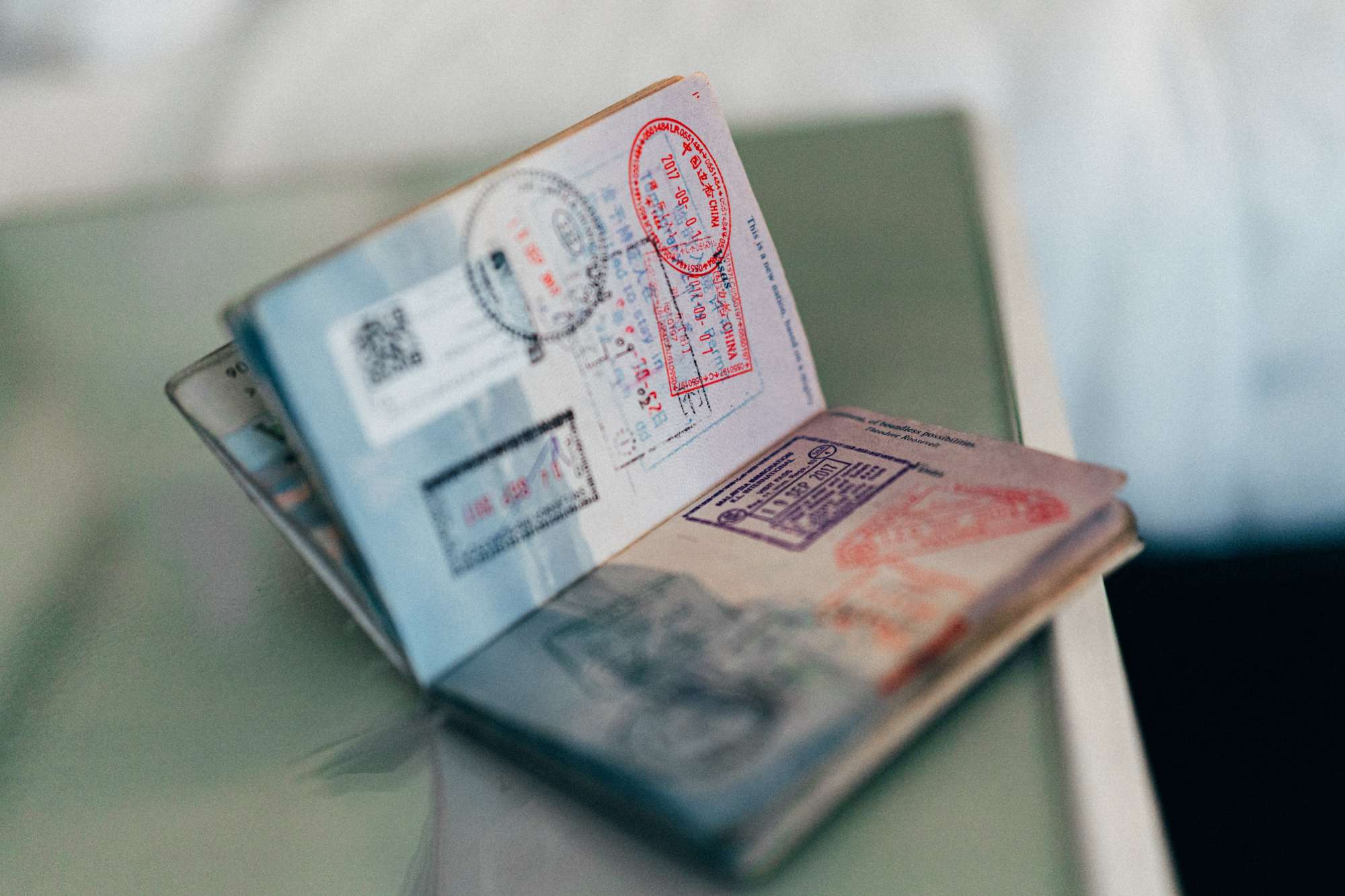
What is a PRTD
The PRTD serves as an alternative travel document specifically designed for permanent residents who do not have a valid PR card but require entry into Canada. It allows them to return to their adopted home and resume their life as a permanent resident.
It is important to note that the PRTD is not a replacement for the PR card. It is intended as a temporary solution for individuals who find themselves in urgent situations where they need to travel to Canada but are unable to obtain or renew their PR card in a timely manner.
To apply for a PRTD, individuals must meet certain eligibility criteria and provide supporting documentation to demonstrate their status as permanent residents. The application process involves submitting an application form, paying the required fees, and providing evidence of your permanent resident status, travel plans, and reasons for needing the travel document.
It is crucial to plan ahead and apply for a PRTD well in advance of your intended travel dates, as processing times may vary. The Immigration, Refugees and Citizenship Canada (IRCC) website provides detailed information on the application process and current processing times.
Having a valid travel document such as a PR card or a PRTD ensures a smooth entry into Canada and reaffirms your status as a permanent resident. It is recommended to keep your travel documents up to date and carry them with you whenever you travel.
If you find yourself in a situation where you need to return to Canada but do not possess a valid PR card, exploring the option of applying for a Permanent Resident Travel Document may be the solution to ensure your safe and lawful entry into the country.
Who should not apply for a Permanent Resident Travel Document?
There are specific categories of individuals who are not eligible to apply for a Permanent Resident Travel Document. These include:
Canadian citizens:
Canadian citizens do not need a Permanent Resident Travel Document as they already have Canadian citizenship, which allows them to travel freely with a Canadian passport.
Foreign Nationals without Permanent Resident status:
Only individuals with Permanent Resident status in Canada are eligible to apply for a Permanent Resident Travel Document. If you do not hold this status, you should explore other appropriate travel documents based on your immigration status.
Permanent residents with a valid PR card:
If you currently possess a valid Permanent Resident (PR) card, there is no need to apply for a Permanent Resident Travel Document. The PR card itself serves as a valid travel document for re-entry into Canada.
Permanent residents seeking to renounce their PR status:
Individuals who wish to voluntarily give up or renounce their permanent residence status should not apply for a Permanent Resident Travel Document. Instead, they should follow the appropriate procedures for renouncing their PR status.
Former Permanent Residents who have lost their PR status:
If you have lost your Permanent Resident (PR) status in the past, you are not eligible to apply for a Permanent Resident Travel Document. The document is intended for current PR cardholders who need to travel and return to Canada.
It is important to understand your specific immigration status and eligibility before applying for a Permanent Resident Travel Document. If you fall into any of the categories mentioned above, you should explore alternative options based on your circumstances.
Preparing your application package

To apply for a Permanent Resident Travel Document (PRTD), it is crucial to gather all the necessary documents and complete the required forms accurately. Follow these steps to ensure a smooth application process:
Application Package
Obtain the application package, which includes an instruction manual and all the forms you need. These forms may vary depending on your nation or territory of residence. It is important to use the correct forms applicable to your situation.
Form Completion:
Read the instructions carefully and fill out the forms accurately. Provide all the requested information, ensuring that it is current and correct. Double-check for any errors or missing details before submitting your application.
Supporting Documents:
Include all the supporting documents required for your application. These may include copies of your permanent resident card, proof of residency, travel itineraries, and any other documents specified in the instruction manual. Ensure that all documents are clear and legible.
Application Fees:
Pay the necessary fees associated with your application. The fee amounts may vary depending on your circumstances and the number of family members requiring travel documents. Refer to the instruction manual for the specific fee structure and accepted payment methods.
Application Submission:
Once you have completed the forms, gathered the supporting documents, and paid the fees, submit your application package according to the instructions provided. Carefully review the requirements for submission, such as mailing address or online submission portal, and follow the specified guidelines.
Application Review:
An immigration officer will review your application to ensure that it is complete and meets the criteria for maintaining permanent residency. It is crucial to demonstrate through your application that you continue to meet the requirements to be a permanent resident of Canada.
Completeness Check:
The immigration authorities will assess your application for completeness. If any information or required documents are missing or incomplete, your application may be returned to you for correction or completion. It is important to provide all the necessary information and documents to avoid delays in processing.
Application Processing:
The processing of your PRTD application will be conducted outside of Canada. It is essential to note that you should not be physically present in Canada during this process.
By carefully preparing your application package and ensuring that all required forms, supporting documents, and fees are included, you can increase the likelihood of a successful PRTD application. If you have any specific questions or concerns regarding your application, refer to the instruction manual or seek guidance from the appropriate immigration authorities or a qualified immigration professional.
Submitting your application and Permanent Resident Card
When applying for a Permanent Resident Travel Document (PRTD), it is essential to follow the proper procedures to ensure a smooth process. Whether you choose to apply online or through a paper application, there are specific guidelines to keep in mind.
If you decide to apply online, you must submit all supporting identification documents through the designated permanent residence site. It is important to note that when applying online, you should provide copies of your permanent resident card and other relevant documents rather than the originals. This is to safeguard your original documents and ensure their security.
For those who opt for a paper application, it is crucial to familiarize yourself with the guidelines provided by your nation or territory regarding the format and submission location. Adhering to these guidelines will help prevent any delays or complications in the processing of your application.
Once you have submitted your application, an immigration officer will carefully review it to ensure its completeness and verify that you meet all the necessary requirements, including the residency obligation. The residency obligation refers to the requirement for permanent residents to accumulate a specified amount of time physically present in Canada.
If the officer determines that you meet the requirements, they will issue you a PRTD. It is important to understand that a PRTD is valid for a single entry into Canada. Its purpose is to allow you to return to Canada and apply for a Permanent Resident Card once you are physically present in the country.
Upon your return to Canada with a valid PRTD, you can proceed to apply for a Permanent Resident Card, which serves as an official proof of your permanent resident status. The Permanent Resident Card provides long-term residency and facilitates your ability to travel to and from Canada.
Remember to carefully follow the instructions provided by the immigration authorities and submit all the required documents accurately and on time. This will help ensure a smooth application process and increase your chances of obtaining the necessary travel document to return to Canada.
If you have any specific questions or concerns regarding the application process or the submission of your permanent resident card, it is advisable to seek guidance from the appropriate immigration authorities or consult with a qualified immigration professional for personalized assistance.
what happens next?
After you have submitted your application.
An immigration officer will review your application to determine your eligibility. Here’s what you can expect based on different outcomes:
If Your Application is Approved:
If your application is deemed complete and you meet all the requirements, you will receive a PRTD counterfoil that will be placed in your passport. This counterfoil serves as your authorization for re-entry into Canada. It is important to keep your passport with the PRTD counterfoil in a safe place and present it to the immigration authorities upon your return to Canada.
If Your Application is Incomplete:
If your application is missing information or required documents, it will be returned to you. In this case, you will need to review the reasons for the incompleteness, make the necessary corrections or additions, and resubmit your application.

If Your Application is Refused:
In the event that your application for a PRTD is denied, you will receive a refusal letter outlining the reasons for the refusal and informing you of your appeal rights. If you wish to challenge the negative decision, carefully follow the instructions provided in the “Notice of Appeal” form and letter that are sent along with the refusal.
If Your Application is Withdrawn:
If you decide to withdraw your application for any reason, you will receive a letter explaining the reasons for the withdrawal. It is important to note that withdrawing your application means you will not proceed with the PRTD process, and you will not receive a PRTD.
It is important to understand that the decision-making process is conducted based on the information and documents you have provided in your application. Personal interviews are not typically conducted for PRTD applications. If you have any questions or concerns regarding the outcome of your application, it is recommended to seek guidance from the appropriate immigration authorities or consult with an immigration professional.
Residency obligation and supporting documents
In order to qualify for a PRTD, you must meet the residency obligation, which requires a specific amount of physical presence in Canada. The requirements differ based on the length of time you have been a permanent resident.
If you have been a permanent resident for five (5) years or more, you must have been physically present in Canada for at least 730 days within the five (5) years immediately before applying for a PRTD.
If you have been a permanent resident for less than five (5) years, you must demonstrate that you will be able to meet the minimum of 730 days of physical presence in Canada within five (5) years from the date you became a permanent resident.
To support your application and prove your residency obligation, you need to provide copies of two pieces of evidence that demonstrate your residency in Canada during the five (5) years leading up to your application. These can include employment records or pay stubs, bank statements, Canada Revenue Agency (CRA) Notice of Assessment for the relevant years, evidence of receiving benefits from Canadian government programs, rental agreements, club memberships, or any other documents that substantiate your fulfillment of the residency obligation.
Please note that you should not send original documents, as they will not be returned to you.
Take Control of Your PR Card Renewal

When it comes to applying for a permanent resident travel document, seeking professional guidance can greatly increase your chances of success. The process of filling out forms and gathering the necessary documents can often be confusing and overwhelming. If you find yourself in need of expert assistance, look no further than Akrami & Associates.
At Akrami & Associates , we specialize in providing legal aid and support to individuals applying for a permanent resident travel document. Our team of experienced professionals is well-versed in the intricacies of the application process and can offer the guidance and expertise you need. We understand the complexities involved and can help simplify the process for you.
If you have any questions or concerns, we encourage you to reach out to us at our office number: (416) 447-2545. Our knowledgeable staff is ready to assist you and provide legal consultation with our immigration professionals. We are committed to helping you navigate through the application process with confidence and ensuring that you receive the best possible support. With Akrami & Associates by your side, you can rest assured that there is always a way forward. Let us help you with your permanent resident travel document application and provide you with the expert assistance you need to achieve your immigration goals. Contact us today and take the first step toward a successful application.
More Related Content
Book a consultation.
One of our Representatives will assist you with your matter. Book Now! Book a Consultation
Call us for more Information
+ 1-416-477-2545 Toll Free: 1-877-820-7121 Call us today
Write Us (Online Form)
Complete our form and one of our Representatives will contact you. Immigration inquiries
Book a Conslutation
Subscribe to our newsletter, there is always a way, about akrami & associates immigration law firm.
Akrami and Associates is a Canadian Immigration firm specializing in helping people to immigrate to Canada. Collectively our team have worked on thousands of cases involving all Canadian immigration matters involving permanent residencies, temporary residencies, and business immigration.
- Denied Entry to Canada
- Temporary Resident Permit (TRP)
- Spousal Sponsorship
- Express Entry to Canada
- Visitor Visa
- Criminal Rehabilitation Canada
Get in Touch
© 2024 Akrami Visa, Inc | All rights reserved | Legal
Ready to Make Your Immigration Dreams a Reality?
Language selection
- Français fr
Application for a Permanent Resident Card (PR card) or Permanent Resident Travel Document (PRTD) [IMM 5444]
Download the form.

Application for a Permanent Resident Card or Permanent Resident Travel Document [IMM 5444] (PDF, 2.7 MB)
You must download the form and fill it out electronically. You must also validate the form before printing and signing it.
Help to download and save this form
- Use your computer. The form may not open on tablets or mobile phones .
- You must save the form on your computer in a place you can remember.
- If you try to open the form in your Internet browser’s PDF viewer , viewing or saving the form will not work.
- You must open the form using Acrobat Reader.
Get help downloading and saving our forms in the Help Centre.
How to open this form in Acrobat Reader
- You need Acrobat Reader version 10 or higher to open our forms.
- Get the latest version of Acrobat Reader .
- Select “ File ” from the top menu
- Click " Open ”
- Find the location where you saved the form, click on the file and click “ Open ”
Complete the form
Read the step by step instructions on how to complete the form.
Show instructions
1 – Applicant Situation
Please choose the option that describes your current situation in order to be directed to the relevant application form to complete.
Choose the option that describes your current situation:
- You’ll apply for a PR card.
- You’ll apply for a PRTD unless you want to renounce your PR status. To renounce your PR status, refer to the Application to Voluntarily Renounce Permanent Resident Status.
1.1 – Choose the option that applies to you:
Applying for a PR card
Choose only one (1) option:
- renew your present PR card (your current PR card has or will expire) or
- replace a PR card that was lost, stolen, destroyed or never received or
- get your first PR card (you have not been issued one before).
Applying for a PRTD
- my PR card was lost, stolen or damaged
- I do not have a valid PR card
1.2 – UCI number
Write your Unique Client Identifier (UCI) in the box at the top right hand corner. Your UCI is an 8 or 10 digit reference number that appears on all correspondence you receive from IRCC. You can also find your UCI on your old PR Card (if you have one). For more information, see Where can I find my UCI?
1.3 – Language of correspondence
Would you like service (correspondence, interview) in English or in French?
1.4 – Date you became a PR in Canada
Write the date you became a permanent resident of Canada. You can find this on your Record of Landing (IMM 1000) or Confirmation of Permanent Residence (IMM 5292 or IMM 5688).
1.5 – Place you became a PR in Canada
Write the city and province in Canada, where you became a permanent resident. If your Record of Landing (IMM 1000) or Confirmation of Permanent Residence (IMM 5292 or IMM 5688) form shows the name of a port of entry (the airport or a border crossing where you became a permanent resident), provide the name of the port of entry as shown on the form.
2 – Personal Details
2.1 – full name.
Write your last name (surname or family name) and given names as they appear on your:
- Record of Landing (IMM 1000),
- Confirmation of Permanent Residence (IMM 5292 or IMM 5688), or
- last permanent resident card (include a photocopy of your last PR Card in your application).
2.2 – Current name
Write your current last name (surname or family name) and given names, if different from question 2.1.
Note: This name will appear on your PR card. If you are applying for a PRTD and have changed your name, please ensure your passport reflects the new name. The name on your passport will appear on your PRTD.
2.3 – Physical Characteristics
Gender: Select one (1) option to identify if you are F -Female, M -Male or X -Another gender.
Note : If you are applying for a replacement/renewal PR card and choose to change your gender to ‘X - Another gender,’ you need to complete the Request form for a Change of Sex or Gender Identifier (IRM 0002) (opens in a new tab) and send it with your application.
If you are applying for a PR card, you will also need to provide:
- Eye Colour: Select the colour of your eyes from the drop down menu. If you have two different eye colours, select the colour of your right eye. If your eyes have a mix of colours, select the closest match from the list.
- Height : Write your height in centimeters.
2.4 – Birth Information
Date of Birth: Select your date of birth.
Country of territory of birth: Select the name of your country or territory of birth.
2.5 – Citizenship
Select the name of your country (or countries or territories) of citizenship. If you are a citizen of more than one country, list your other country of citizenship in the second space.
2.6 – Address in Canada (required only for PR card applicants)
Write the full address where you live in Canada with the postal code.
2.7 – Mailing address (required only for PR card applicants)
Write your mailing address, with the postal code, if different from your address in question 2.6.
All correspondence will be sent to this address if different from question 2.6 and if an e-mail address is not provided in your application.
Note : Your PR Card will be sent to your residential address (the address where you live). PR Cards will only be mailed to post office (PO) boxes if this is your residential mailing address. It is important to note that PR cards will not be mailed to third party addresses (e.g. representatives, family members). If you do not provide your residential address, processing will be delayed.
2.8 – Your address outside Canada (required only for PRTD applicants)
Write the full address where you live outside Canada.
2.9 – Phone number
Tell us where you can be reached by telephone.
2.10 – Alternate phone number
If applicable, provide an alternative telephone number, which can include a business or cellular telephone.
2.11 – Email address
Provide an email address where you can be contacted.
Note : By providing your e-mail address, you are authorizing IRCC to send your correspondence to this e-mail.
2.12 – Marital status
Select from the drop down menu to identify your current marital status.
2.13 – Date of marriage/common-law
If you selected married or common-law, provide the date you were married or entered into a common-law relationship.
3 – Immigration History
Check the box that applies to you for questions 3.1 - 3.5.
3.1 – Removal order
Check one (1) box, Yes or No, to tell us if you have ever been issued a removal order from Canada.
3.2 – Inadmissibility report
Check one (1) box, Yes or No, to tell us if an immigration officer or a Canadian Border Service Agency officer has ever issued you an inadmissibility report under Subsection 44(1) of the Immigration and Refugee Protection Act or has made the decision that you have not met the residency obligations for Canadian permanent residents.
3.3 – Lost PR status
Check one (1) box, Yes or No, to tell us if you have ever lost your status as a PR of Canada.
3.4 – Appeal to Immigration and Refugee Board
Check one (1) box, Yes or No, to tell us if you have ever submitted an appeal to the Immigration Appeal Division of the Immigration and Refugee Board against a decision on the residency obligation.
3.5 – Travel documents
Check the box(es) only if you have ever been issued one or both of the following documents:
- Travel document
- Permanent Resident Travel Document (PRTD)
3.6 – Immigration History Details
If you answered Yes to any of the questions from 3.1 to 3.4 and/or checked a box in question 3.5, use the space provided to write down details for each answer.
Note: If additional space is required, please include a separate document.
4 – Personal History
4.1 – address history.
Your Address History: You must list all the addresses you have lived at, inside and outside Canada for the past five (5) years, or since becoming a permanent resident if less than five (5) years ago. You must account for each month during this time. Leave no gaps in your travel, if applicable. Please ensure you list your addresses from the most recent address (your current address) to the oldest.
4.2 – Work/educational history
Your Work/Educational History: You must list all your work and educational history inside and outside Canada for the past five (5) years or since becoming a permanent resident if less than five (5) years ago. Please ensure you list your work and educational activities from the most recent (current) to the oldest.
You must account for each month during this time:
- If you were self-employed, you must provide details of your self-employment.
Stating “not applicable” (or “N/A”), or leaving a question blank may result in your application being returned as incomplete.
5 – Residency Obligation – Time Spent Outside Canada
5.1 – travel outside canada.
Check one (1) box, Yes or No, to identify if you travelled or lived outside Canada in the past five years.
If you answered No, you will move on to the next question 5.7.
5.2 – Employment outside Canada
Check one (1) box, Yes or No, to tell us if you have been employed on a full-time basis by a Canadian business outside Canada or in the federal public administration or the public service of a province, while you were absent from Canada.
5.3 – Accompanying Canadian citizen spouse outside Canada
Check one (1) box, Yes or No, to tell us if you have been accompanying a Canadian citizen who is your spouse, common-law partner, or in the case of a child, your parent, while you were absent from Canada.
Note: Please provide proof of this persons Canadian citizenship and relationship to you as supporting documents.
5.4 – Accompanying Canadian PR spouse outside Canada
Check one (1) box, Yes or No, to tell us if you have been accompanying a PR who is your spouse, common-law partner, or in the case of a child, your parent, and who is employed on a full-time basis by a Canadian business outside Canada or in the federal public administration or the public service of a province, while you were absent from Canada.
5.5 – Time spent outside Canada
You must list all your absences from Canada in the past five (5) years, or since becoming a permanent resident if less than five (5) years ago, in the table provided. List the reasons for your absences from Canada based on the situations A to C. If none of these situations apply to you, select Other and provide a reason for absence which may include, vacations, absences due to employment that does not pertain to a Canadian business, and any other time you left Canada. Please ensure you list your absences in order from the most recent travel to the oldest.
Note: If you leave Canada and come back the same day, you do not need to include this travel as an absence in the table.
Period to be assessed :
The date in the “From” field should be the date from the past five (5) years preceding this application or since becoming a permanent resident if less than five (5) years ago.
The date in the “To” field, should be the date when you sign and submit your application form.
Your reason for absence must be one of the following options:
A: You have been employed on a full-time basis by a Canadian business or in the federal public administration or the public service of a province.
B: You have been accompanying a Canadian citizen who is your spouse or common-law partner or, in the case of a child, your parent.
C: You have been accompanying a PR who is your spouse or common-law partner or, in the case of a child, your parent and who is employed on a full-time basis by a Canadian business or in the federal public administration or the public service of a province.
Other: employment, studying, vacation, etc.
Note : If reasons A, B, or C apply to only a portion of your trip outside of Canada, and you were also abroad for a separate reason, please indicate this absence as two separate lines in the table. Do not enter any time you spent in transit while travelling through Canada. This does not count as travelling outside of Canada.
For example: John Doe travelled from Canada to United Kingdom, France and Italy in the past five years and for his time in Italy he was accompanying his Canadian spouse. This is how he would input his travel history.
Note: The day you departed and returned to Canada counts towards your residency as days you were in Canada, as such, those days will be excluded from the days counted towards the time you spent outside of Canada.
Enter the correct number of days you were absent from Canada, as a processing officer will exclude the day you departed and returned to Canada when processing your application.
Important :
If your total time spent outside Canada is less than 1095 days, you appear to meet the residency requirements.
If your total time spent outside Canada excluding reasons A, B or C, is equal to 1095 days or more, you may not meet the residency requirements.
If you have time spent outside of Canada as per situations B and C, please complete question 5.6 to provide the relationship of this person to you and their immigration status.
You may wish to proceed to question 5.7 to include any other information related to your personal circumstances that you feel would justify the retention of your PR status, if you appear to not be meeting your residency obligation. See Appendix A for more information on meeting the residency obligation.
5.6 – Spouse/partner details
Please provide details of the spouse or common law partner or parent that you have been accompanying. You must include with your supporting documents, a copy of proof of your relationship and the persons immigration status.
5.7 – Humanitarian and compassionate grounds
Use this space to provide any humanitarian and compassionate considerations that would justify the retention of your PR status should an officer determine that you do not meet the residency obligation,
Refer to the instruction guide for more information.
6 – Details Concerning Lost, Stolen, Damaged or Never Received Permanent Resident Card
Fill out this section only if you are applying to replace a lost, stolen, damaged or never received permanent resident card.
If you are applying to replace your damaged card, please send your damaged PR card with your application.
6.1 – PR card number
Provide your PR card number, if known.
6.2 – Date of issue
Provide the date of issue found on your PR card, if known.
6.3 – Status of PR card
Tell us if your PR card was lost, stolen, damaged or never received and provide the date and country or territory, if known.
6.4 – PR card (details)
In the space provided, share as much detail as possible regarding the circumstances of your PR card.
6.5 – Efforts to locate PR card
If you have lost your PR card, use the space provided to share the efforts you made to locate your PR card.
6.6 – Declaration (promise to destroy)
Check the box to confirm you have read and understood the declaration pertaining to the information you provided for your PR card.
7 – Consent to Disclose Information
History of Entries to Canada and income tax information and filing history: If you authorize us to collect the history of your entries into Canada from the Canada Border Services Agency (CBSA), check ‘Yes.’ If you check ‘No,’ you may need to ask for your history of entries directly from the CBSA and send it to us, which could result in processing delays.
Check “Yes” and provide your Social Insurance Number (SIN) if you authorize IRCC to ask for your income tax and residency information for any taxation years needed to help the department determine if you meet the residency obligation as set out in Section 28 of the Immigration and Refugee Protection Act.
If you check ‘No’ :
- you may need to ask for your income tax and residency information directly from the CRA, or
- your application may be sent to a local office for further review.
Either outcome may result in processing delays.
8 – Consent and Declaration of Applicant
Read all of the statements.
Click on the ‘ Validate ’ button located at the top of the form
Important information: Validating the form before printing makes sure that you have answered all the mandatory questions. This will help you to avoid delays in processing your application.
Sign and date the application form. Once the application form is filled out in the PDF, it should be printed and signed by hand.
- If you are less than 14 years of age: one of your parents or a legal guardian must sign the application.
- If you are 14 years of age or more but less than 18 years of age: Your application must be signed by you and one of your parents or a legal guardian.
Important information: Your application will be returned to you as incomplete if:
- the form is not signed and dated;
- your application is stale-dated (dated more than 90 days before we receive it;
- post-dated (dated into the future); or
- your application form contains electronic signatures. It must be signed and completed in original format.
Page details

- Forums New posts Search Forums
- Members Registered members Current visitors Recent Activity
- Free Assessment
Is PR Card a Travel Document for Citizenship application
- Thread starter arif.jabbar
- Start date Oct 16, 2017
arif.jabbar
Hero member.
Hello Seniors: Is PR card considered as travel document for citizenship application application or just the passports during eligibility period are considered travel documents? Thxs,
Star Member
I think PR card is an immigration status document .. you can not travel with it, or enter another country .. you'd need a passport for that ..
arif.jabbar said: Hello Seniors: Is PR card considered as travel document for citizenship application application or just the passports during eligibility period are considered travel documents? Thxs, Click to expand...
Thank you all.
CANADIANZ said: No, PR card is not a travel document. Also, you are not required to send a copy of PR or COPR (landing paper) with your application. Click to expand...
guddylover said: It says to include copies of one of the following in which COPR and PRC is listed. The instruction guide and checklist contradict each other. I guess it is better to include whats requested and more rather than be short and they will have reasons to return it. Click to expand...
CANADIANZ said: No, it doesn't, please see Step 3 – Gather your documents Link: http://www.cic.gc.ca/english/information/applications/guides/CIT0002ETOC.asp Date Modified: 2017-10-12 Click to expand...
guddylover said: Kind of weird, I saw that part last week immediately when they changed to 3/5. Anyway, I had included the COPR and PRC (that could be used for personal ID), I don't think they would return your application because you included what was not in the checklist tho, what do you think? Click to expand...
guddylover said: Like you said: Date modified 2017-10-12. What happens to those that sent their application on 2017-10-11 because thats when they first rolled out the forms Click to expand...
Winter is here! Check out the winter wonderlands at these 5 amazing winter destinations in Montana
- Travel Destinations
- United States
What Is A Travel Document From USCIS
Published: November 2, 2023
Modified: December 28, 2023
by Poppy Beckett
- Plan Your Trip
Introduction
Welcome to our comprehensive guide on travel documents from USCIS. If you are planning to travel outside of the United States and you are not a U.S. citizen or a permanent resident, you will likely need a travel document to re-enter the country. The U.S. Citizenship and Immigration Services (USCIS) issues travel documents to individuals who have a recognized reason to travel internationally but do not possess a valid U.S. passport.
In this article, we will explore what a travel document is and the different types available. We will also guide you through the application process and highlight important considerations to keep in mind. Whether you are a lawful permanent resident, a refugee, or an asylee, understanding the travel document requirements and procedures will help ensure a smooth and hassle-free travel experience.
It’s important to note that travel documents are not the same as visas. While visas allow entry into a foreign country, travel documents are used for re-entry into the United States. These documents are typically granted to individuals who are unable to obtain a passport from their home country or have a special circumstance that requires them to travel.
Now, let’s dive deeper into the world of travel documents and discover the different types available to individuals in need.
Definition of a Travel Document
A travel document, issued by the U.S. Citizenship and Immigration Services (USCIS), is an official document that allows individuals who are not U.S. citizens or permanent residents to re-enter the United States after traveling abroad. It serves as a substitute for a U.S. passport and is granted to individuals who have a legitimate reason to travel but cannot obtain a passport from their home country.
Travel documents are essential for individuals who are lawful permanent residents, refugees, asylees, or who have temporary protected status (TPS) in the United States. If you fall into one of these categories and need to travel internationally, obtaining a travel document is crucial for facilitating your re-entry into the country.
These documents are intended for individuals who are unable to obtain a passport from their home country due to reasons such as political conflicts, lack of diplomatic relations, or other exceptional circumstances. They are only valid for travel purposes and do not confer citizenship or permanent residency status.
Additionally, it’s important to note that travel documents are not valid for entry into countries other than the United States. If you plan to travel to other countries, you may need to apply for a visa from the specific country’s embassy or consulate.
Now that we have a clear understanding of what a travel document is, let’s explore the different types available to individuals in need.
Types of Travel Documents
The U.S. Citizenship and Immigration Services (USCIS) offers different types of travel documents to meet the specific travel needs of various individuals. Understanding these different types will help you determine which one is applicable to your situation. The main types of travel documents include:
- Refugee Travel Document: This document is issued to individuals who have been granted refugee or asylum status in the United States. It allows them to travel abroad and return to the U.S. It is essential for refugees and asylees to obtain this document before leaving the country, as it serves as proof of their legal status and facilitates their re-entry.
- Re-entry Permit: Lawful permanent residents of the United States, also known as green card holders, can apply for a re-entry permit. This document allows them to travel abroad for extended periods of up to two years without jeopardizing their permanent resident status. Having a re-entry permit is especially crucial for green card holders who plan to spend significant time outside of the U.S., as their absence may otherwise be seen as abandonment of their residency.
- Advance Parole Document: Individuals who are in the process of adjusting their status in the United States, such as those applying for a green card, may apply for an advance parole document. This document grants them permission to travel internationally while their adjustment of status application is pending. It is important for applicants not to travel without this document, as it can lead to the abandonment of their application.
- Carrier Documentation: This type of travel document is issued to certain individuals who are inadmissible to the United States but have obtained permission to travel to the country for specific purposes, such as medical treatment or court proceedings. It is typically provided to individuals in exceptional circumstances who need to travel but do not meet the usual requirements for a visa or passport.
Each type of travel document has its own specific requirements and application procedures. It is essential to carefully review the eligibility criteria and follow the instructions provided by USCIS to ensure a successful application process.
Now that we have explored the different types of travel documents, let’s move on to the next section and learn about the application process.
How to Apply for a Travel Document
When applying for a travel document from USCIS, it is crucial to follow the proper application process to ensure a smooth and successful outcome. The specific steps may vary depending on the type of travel document you are applying for, but here is a general overview of the application process:
- Collect the required documents: Start by gathering all the necessary documents for your specific travel document application. This may include proof of your immigration status, identity documents, supporting evidence, and any additional documentation requested by USCIS.
- Complete the application form: Fill out the appropriate form for the type of travel document you are applying for. USCIS provides specific forms for each document, which can be found on their website or requested by mail. Ensure that you fill out the form accurately and provide all the required information.
- Pay the filing fee: Most travel document applications require a filing fee. The fee amount may vary depending on the type of document and your age. Check the USCIS website or consult the specific application form instructions for the correct fee amount and acceptable payment methods.
- Submit the application: Once you have completed the application form and gathered all the necessary documents, submit your application package to USCIS. This usually involves mailing the application and supporting documents to the appropriate USCIS lockbox facility. Make sure to follow the mailing instructions provided on the form and include the correct fee payment.
- Attend biometrics appointment (if required): Depending on the type of travel document, you may need to attend a biometrics appointment at a USCIS Application Support Center. During this appointment, your fingerprints, photograph, and signature will be taken for background checks and identification purposes.
- Monitor the status of your application: After submitting your application, you can check the status online through the USCIS website using your receipt number. USCIS will also notify you by mail regarding any updates or if additional information is required.
- Receive your travel document: If your application is approved, you will receive your travel document by mail. Make sure to review the document carefully for accuracy and check the expiration date. It is recommended to make copies and keep the original in a safe place.
It is important to note that the processing time for travel document applications can vary. It is advisable to apply well in advance of your planned travel dates to allow for sufficient processing time.
Now that you understand the general application process, let’s move on to some important considerations to keep in mind when applying for a travel document.
Important Considerations
When applying for a travel document from USCIS, there are several important considerations to keep in mind to ensure a smooth and successful application process. These include:
- Application timing: It is crucial to apply for a travel document well in advance of your planned travel dates. Processing times can vary, and you want to allow sufficient time for USCIS to review and approve your application. Submitting your application early will also give you enough time to address any potential issues or provide additional information if needed.
- Accuracy and completeness: When completing the application form and gathering supporting documentation, be sure to provide accurate and complete information. Any errors or missing information can delay your application or even result in a denial. Double-check all forms and documents before submitting them to USCIS.
- Travel plans: Before applying for a travel document, it is essential to have a clear understanding of your travel plans. Make sure you have a valid reason for travel and know the dates and destinations of your intended trip. USCIS may require this information for processing your application.
- Validity period: Travel documents have an expiration date, so it is important to carefully review the document once you receive it. Take note of the expiration date and plan your future travels accordingly. Keep in mind that you may need to renew your travel document before it expires if you have further international travel plans.
- International travel restrictions: Research and stay informed about any travel restrictions or special requirements for the countries you plan to visit. Some countries may have specific entry requirements that you need to meet, such as obtaining a visa or fulfilling health-related prerequisites. Ensure that you have all the necessary documents and meet the requirements before traveling.
- Consult with an immigration attorney: If you have any questions or concerns regarding your eligibility for a travel document or the application process, it may be helpful to consult with an immigration attorney. They can provide guidance based on your specific circumstances and ensure that you adhere to all necessary requirements.
By keeping these considerations in mind and taking the necessary steps to prepare and submit your application accurately, you can increase the chances of a successful application outcome and enjoy a hassle-free travel experience.
Now, let’s conclude our comprehensive guide on travel documents from USCIS.
Obtaining a travel document from the U.S. Citizenship and Immigration Services (USCIS) is crucial for individuals who are not U.S. citizens or permanent residents and need to travel internationally. Whether you are a refugee, asylee, lawful permanent resident, or in the process of adjusting your status, having a travel document will facilitate your re-entry into the United States after traveling abroad.
In this comprehensive guide, we have covered the definition of a travel document and explored the different types available, including the refugee travel document, re-entry permit, advance parole document, and carrier documentation. Each type caters to specific circumstances and requirements.
We have also discussed the application process, emphasizing the importance of collecting the required documents, completing the application accurately, paying the filing fee, and submitting the application to USCIS. We highlighted the significance of attending a biometrics appointment if necessary and monitoring the status of your application.
Additionally, we provided important considerations to keep in mind, such as applying well in advance, ensuring accuracy and completeness, planning your travel, checking the validity period of your travel document, and staying informed about international travel restrictions. Consulting with an immigration attorney can also be beneficial if you have any concerns or questions.
Remember, a travel document is an essential piece of identification that allows you to re-enter the United States after international travel. It is crucial to follow the proper application process and adhere to all requirements set by USCIS to ensure a smooth and successful application outcome.
Now that you are equipped with a better understanding of travel documents from USCIS, you can confidently navigate the application process and embark on your travel plans with ease.
Safe travels!

- Privacy Overview
- Strictly Necessary Cookies
This website uses cookies so that we can provide you with the best user experience possible. Cookie information is stored in your browser and performs functions such as recognising you when you return to our website and helping our team to understand which sections of the website you find most interesting and useful.
Strictly Necessary Cookie should be enabled at all times so that we can save your preferences for cookie settings.
If you disable this cookie, we will not be able to save your preferences. This means that every time you visit this website you will need to enable or disable cookies again.

IMAGES
VIDEO
COMMENTS
Travel Documents. If you wish to return to the United States lawfully after traveling outside the United States, you generally must have a: Valid entry document, such as a Permanent Resident Card (Green Card) or nonimmigrant visa; or. Valid and unexpired travel document. The type of document you need varies depending on your immigration status ...
A permanent resident travel document (PRTD) is a temporary official document proving your status as a permanent resident in Canada. You need a PRTD if you are a permanent resident outside Canada without a valid PR card and you plan to travel to Canada by any commercial transporter.
If you're outside Canada without a valid PR card, you need to apply for a permanent resident travel document (PRTD). A PRTD is normally only valid for one single entry. You should apply for a new PR card as soon as you resume residence in Canada.
1. Get the application package. To apply for a permanent resident travel document (PRTD), you must submit a complete application package including all required forms and country or territory specific supporting documents. The application package includes the instruction guide and all the forms you need to fill out.
A PR Travel Document is a travel document issued to permanent residents of a country who do not possess a valid passport from their country of origin. This document serves as a replacement for a passport, allowing permanent residents to travel abroad and re-enter the country of residence.
The Permanent Resident Travel Document (PRTD) serves as an official temporary document that affirms an individual's permanent resident status in Canada. It provides evidence to transportation entities that the bearer is allowed to travel to Canada as a permanent resident, even in the absence of a valid Permanent Resident (PR) card.
A PRTD is a single-entry document for permanent residents of Canada who do not have a valid PR card. Learn who is eligible to apply for a PRTD and how to submit an application.
I-131, Application for Travel Document. ALERT: On Jan. 31, 2024, we published a final rule in the Federal Register, that adjusts the fees required for most immigration applications and petitions. The new fees will be effective April 1, 2024. Applications and petitions postmarked on or after April 1, 2024, must include the new fees or we will ...
Course: PR Travel Document (PRTD) To be eligible for a PRTD, you must: Step 1: Get the Application PRTD Application Package. Step 2: Print and use your Document Checklist - IMM 5627. The first 8 items in your Document Checklist detail: Step 3: Filling in IMM 5524 Application for Permanent Resident Travel Document.
A Permanent Residence Card (PR Card) is an identification document issued by IRCC that proves your PR status in Canada. It is also a travel document that you need to enter Canada, and it is valid for up to five years.
If you plan on being absent from the United States for longer than a year, it is advisable to first apply for a reentry permit on Form I-131.Obtaining a reentry permit prior to leaving the United States allows a permanent or conditional permanent resident to apply for admission into the United States during the permit's validity without the need to obtain a returning resident visa from a U.S ...
Permanent residents (PR) of Canada need a valid PR card when: travelling to Canada by public transit (plane, train, bus or boat) transiting through a Canadian airport. If your PR card is expired or you lost it, you can apply for a PR travel document (PRTD) to travel to Canada. If you don't have a PR card or a PRTD, you may not be able to ...
In efforts to keep both travelers and locals safe, all passengers entering Puerto Rico are required to complete the Travel Declaration Form and present a negative test, regardless of vaccination status. From February 2nd, vaccinated travelers arriving in Puerto Rico on domestic flights will no longer have to present a negative COVID-19 test on ...
A PRTD is a document you need to return to Canada by plane, train, bus or boat if you don't have a valid PR card. Learn how to apply for a PRTD, when you need it, and what happens if your PR card expires outside Canada.
Our PR lawyers in Toronto are experienced and knowledgeable to handle any legal complications and guide you through visa application process. Given all the requirements are met, we guarantee a smooth transition for all your PR needs. To book a consultation, call 416-447-6118. The typical processing time for PRTD Canada is anywhere from two to ...
What is a PRTD. The PRTD serves as an alternative travel document specifically designed for permanent residents who do not have a valid PR card but require entry into Canada. It allows them to return to their adopted home and resume their life as a permanent resident. It is important to note that the PRTD is not a replacement for the PR card.
Automated travel document inspection at Dubai Airport. A travel document is an identity document issued by a government or international entity pursuant to international agreements to enable individuals to clear border control measures. Travel documents usually assure other governments that the bearer may return to the issuing country, and are often issued in booklet form to allow other ...
You can apply for a permanent resident travel document if you: are a permanent resident, do not have a valid PR card showing your PR status, are outside Canada, and. will return to Canada by airplane, boat, train or bus. Next: How to apply. Date modified: 2022-10-31.
When filling up there was this question "Have you ever been issued any of the following, Travel document or... Client Portal +1(514) 937-9445 or Toll-free (Canada & US) +1 (888) 947-9445. ... (when PR was approved). After reading this forum it seems I should not have selected them. What should I do at this time? Thanks! lukeortolani Hero Member.
When looking at the Citizenship application, it states I must include "photocopies of biographical pages of all valid and expired passports or travel documents you had in the past 5 years. The biographical page means the page where it has your name, photo, passport/travel document number, issue date and expiration date.''
Application for a Permanent Resident Card (PR card) or Permanent Resident Travel Document (PRTD) [IMM 5444] ... Permanent Resident Travel Document (PRTD) 3.6 - Immigration History Details. If you answered Yes to any of the questions from 3.1 to 3.4 and/or checked a box in question 3.5, use the space provided to write down details for each ...
Oct 16, 2017. #6. CANADIANZ said: No, PR card is not a travel document. Also, you are not required to send a copy of PR or COPR (landing paper) with your application. It says to include copies of one of the following in which COPR and PRC is listed. The instruction guide and checklist contradict each other.
Definition of a Travel Document. A travel document, issued by the U.S. Citizenship and Immigration Services (USCIS), is an official document that allows individuals who are not U.S. citizens or permanent residents to re-enter the United States after traveling abroad. It serves as a substitute for a U.S. passport and is granted to individuals ...